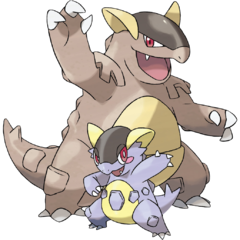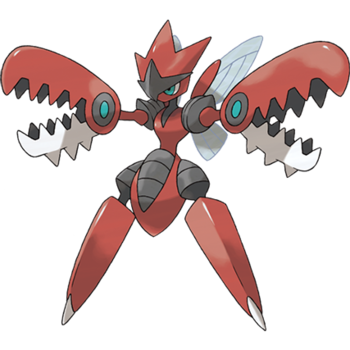0092: Gastly / Ghos (ゴース goosu)
0093: Haunter / Ghost (ゴースト goosuto)
0094: Gengar / Gangar (ゲンガー gengaa)

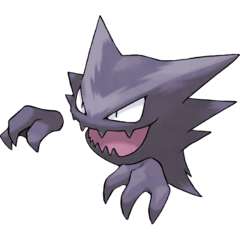

From Pokémon X and Y onward, Gengar became one of the few Pokémon to gain access to Mega Evolution. While Mega Evolved, it boasts even higher Special Attack and Speed stats with a tiny buff to defenses, as well as the Shadow Tag ability to prevent its prey from fleeing battle.
A special Gengar caught in a Raid Battle in Galar has the ability to Gigantamax, giving it access to the Ghost-type move G-Max Terror, that deals damage and prevents any hit opponent from escaping.
- Action Bomb: They can learn Self-Destruct and Explosion, possibly because they're called the Gas Pokémon.
- Alice Allusion: Gengar seems to be partially based on the Cheshire Cat, with its pointy ears, wide grin, and status as a trickster.
- Ax-Crazy: Mega Evolving turns Gengar into a bloodthirsty entity that tries to kill everything around it, even its trainer.
- Balance Buff: The whole line started pretty decently, but it was notoriously helped by the Physical/Special split, as both of its types used to be physical prior to Gen IV. Now Gengar could use its massive Special Attack alongside STAB to put a massive dent on the opponent's team.
- Bedsheet Ghost: The shiny forms of Mega and Gigantamax Gengar are stark white to invoke a traditional ghostly appearance, rather than its default shadow/cloud of noxious gas shape.
- Being Watched: According to the X entry, if you think you are, there's a Haunter nearby.
- Breakout Character: Less remarked on, but its status as the Ghost type combined with its continued viability in battles has made Gengar quite the recurring face in the franchise, even being the only one to get both a Mega Evolution and a Gigantamax form that's not a Kanto Starter. It was also one of the non-Gen 8 Pokémon on Ash's Gen 8/World Champion team alongside giants like Lucario and Dragonite.
- Boss Battle: Three times. The first is as Elite Four Agatha's signature Mon in Gen I. The second is as the strongest Mon of Morty, the fourth Gym Leader of Johto. The third is as Allister's strongest Pokémon in Galar (Shield version only), being able to Gigantamax.
- Casting a Shadow: Ghost-types that can hide in shadows and are able to trap their opponents.
- Cheshire Cat Grin: This has always been Gengar's default expression. In fact, Gengar as a whole (and Haunter to a lesser extent) appears to be based on the Cheshire Cat.
- Combat Pragmatist: They learn Dark-type moves naturally, namely Sucker Punch, Payback, and Dark Pulse.
- Com Mons: In Legends: Arceus and Scarlet and Violet, Gastly and Haunter are very common at night.
- Confusion Fu: The Gastly line learns several status moves, as well as Ghost-, Dark- and Psychic-type attacking moves via levelling up, but they can also learn a ridiculously wide variety of Normal-, Poison-, Fighting-, Grass-, Electric-, and Fairy-type attacking moves via TM. Through breeding and move tutor, they can even learn a handful of Fire- and Ice-type moves.
- Dark Is Not Evil: Despite their menacing appearances and scary Pokédex entries, they're usually mischievous pranksters rather than outright malicious.
- Depending on the Artist: Gengar's shade of purple varies between adaptations and the games. In the anime, it's almost black, while the games tend to switch between different shades of purple, sometimes within the same generation.
- Developer's Foresight: Due to being partially sunken into the ground, Mega Gengar is immune to the move Telekinesis (a move which involves lifting the opponent into the air to bypass accuracy checks and always hit them).
- Discard and Draw:
- In Generation VI, Gengar exchanges its Levitate ability for Shadow Tag when it Mega Evolves. Because of this, Mega Gengar is now vulnerable to Ground-type attacks but can prevent its opponent from switching out.
- In Generation VII, Gengar no longer has Levitate, and instead has Cursed Body as an ability. It can't avoid Ground-type attacks anymore, which it is weak to, but it can at least benefit from Terrain effects now and also dispel Toxic Spikes upon switching in.
- A Dog Named "Dog": Haunter's Japanese name is "Ghost".
- Doppelgänger: Gengar likes to mimic the shadows of people, and its Meaningful Name is based on the latter half of Doppelganger.
- Early-Installment Weirdness: In Generation I, the wild Gastly and Haunter of Pokémon Tower can only be seen and properly encountered with a Silph Scope; without it, they'll appear as ghosts that terrify the player's party otherwise and cannot be caught. This unique aspect or trait is dropped in all subsequent games (barring Kanto remakes), where the Gastly line is encountered normally without special items like most other Pokémon.
- Energy Ball: They can be taught the Grass-type move of the same name via TM, which is literally a ball of natural energy. Less literally, Gengar can also learn Shadow Ball and Focus Blast.
- Evil Is Deathly Cold: Gengar's presence cools the area around it by nearly 10°F. It can also learn Ice Punch and Icy Wind.
- Fire, Ice, Lightning: Can learn the three elemental punches via breeding or tutor. However, it can't make good use of them after Generation III.
- Floating Limbs: Haunter's hands are completely disconnected from its body.
- Foil: The line has three parallels to three other lines, and they all evolve by trading.
- They're primarily a foil to the Abra line:
- They're Ghost/Poison types to the Abra line's Psychic type, resulting in both sides having an advantage against the other. Both are powerful Squishy Wizard types, with Gengar having a bit less Sp Atk and Speed than Alakazam in exchange for slightly less horrible HP, Atk, and Def, though it's still not great. Both Alakazam and Gengar also received a Mega Evolution in Gen VI, retain their similar stat distribution through them, and Alakazam even had its Sp Def increased to match Gengar's base stat total of 500, while Mega Alakazam received a Sp Def increase in Gen VII to match Mega Gengar's base stat total of 600. Even their Dex entries contrast each other, as the Abra line is described as being intelligent but benign, while the Gastly line is described as mischievous, preying on unsuspecting victims.
- Outside the main series, the anime has Ash recruiting a Haunter to battle Sabrina's Kadabra, while another episode has an ancient Gengar battle with an ancient Alakazam. Gengar and Alakazam's original cards in the TCG both have 80 HP, one attack that required three Psychic energy, doing 30 damage with an extra effect, and both had an ability that let them move damage counters around, with Alakazam's moving the player's damage counters and Gengar's moving the opponent's damage counters.
- They received another foil in the Machop line in Sword and Shield, as the Abra line was initially absent from those games.
- Both Machamp and Gengar are complete opposites in role, as Machamp is a Mighty Glacier on the physical side, and Gengar is a Squishy Wizard on the special side. Their types are opposite as well, as Machamp's Fighting type does nothing to Gengar's Ghost type. Fighting types are usually depicted as honourable and just, which goes against Ghost types which are usually depicted as mischievous pranksters. In Sword and Shield itself, both Machamp and Gengar have a version-exclusive Gigantamax form that's the Signature Mon of a Gym Leader. Gigantamax Machamp is exclusive to Sword and is the ace of Gym Leader Bea, while Gigantamax Gengar is exclusive to Shield and is the ace of Gym Leader Allister.
- To a lesser extent, they are a foil to the Geodude line. Gastly and Geodude are dual-typed as Ghost/Poison and Rock/Ground respectively. They evolve once at Level 25 into Haunter and Graveler, respectively, and then again into Golem and Gengar when traded. Golem is a physical Mighty Glacier with high Attack and Defense, while Gengar is a special Squishy Wizard with high Special Attack and Speed. They also start as essentially floating heads in their base form, grow additional limbs in their second, and are most grounded with two arms and two legs in their last evolution.
- They're primarily a foil to the Abra line:
- Fragile Speedster: They're pretty fast and have great Special Attack, letting them hit hard, but their defenses aren't very good.
- Green Thumb: They are capable of learning Giga Drain and Energy Ball.
- Ghostly Chill: Gengar cools the area around it. Noticing this chill means that it's close and probably wants to put a curse on you.
- Hellgate: According to Sword's Pokédex entry, it's rumored that Gigantamax Gengar's gaping maw leads directly to the afterlife.
- I Just Want to Have Friends: One of Gengar's Pokédex entries says it wants a traveling companion, and since it once was human, it tries to take other humans' lives to create said companion.
- It Amused Me: Even at its most benevolent, Gengar loves scaring the ever-loving daylights out of people just for some giggles.
- Larynx Dissonance: In the games, Haunter and Gengar have very deep cries, yet have a 50/50 chance of being female. Gastly only faces this trope in the anime.
- Living Shadow: Gengar likes to pretend to be people's shadows. Appropriately, it is known as the Shadow Pokémon.
- Magikarp Power: The entire line's high base Special Attack and Speed are hampered by their natural learnset, preventing them from being true Disc One Nukes if the player trades in a low-level Gastly or Haunter/Gengar from another game. They learn their first proper offensive move, Shadow Ball, near Level 30, which in most games is approximately mid-game — prior to that, their other offensive moves have below average base damage and work off their abysmal base Attack stat. The TMs that would patch up their initially poor learnset are only found from the mid-game onwards. These factors limit their offensive capability and prevent them from sweeping through the early game.
- Maniac Tongue: The line is frequently characterized as mischievous or even murderous, and each of them sport an Overly-Long Tongue that sucks the life out of those that they lick.
- Master of Illusion: All three do this at least once in the anime.
- Multiform Balance: In Gen VI, Mega Gengar loses its immunity to Ground in exchange for some hefty stat boosts (and a different useful ability, Shadow Tag), and in Generation VIII, Gigantamax Gengar loses access to the default Ghost-type Max Move in exchange for a unique one. On top of that, Generation VII removing Gengar's immunity to Ground-type moves means there are rare situations where it's preferable to just use Haunter (whose stats aren't really that much worse than Gengar's).
- Mythology Gag: Gigantamax Gengar borrows several elements of its design from Mega Gengar, being half-buried in the ground and boasting a G-Max Move that prevents its target from switching out.
- Nerf: In Generation VII, Gengar has its ability changed from Levitate to Cursed Body, meaning it's now vulnerable to Ground-type attacks, and it's too squishy to use Cursed Body effectively.
- Our Ghosts Are Different: Gastly is really more like a sentient cloud of noxious gas. Haunter also has traits of this, being described in some of its Pokédex entries as having a gaseous tongue and hands. Appropriately, they are known as Gas Pokémon. In Pokémon Moon's Pokédex, Gengar is stated to have once been human, which would make it (and Haunter and Gastly by extension) a ghost in truth.
- Overly-Long Tongue: Haunter's licks are said to cause paralysis, convulsions, and death. The other forms in the evolutionary line are quite well-endowed in that department, too. In the case of Gastly, its tongue is sometimes depicted to be larger than its body.
- Perpetual Smiler: The entire line in their sprites. In other adaptations, they are occasionally shown frowning.
- Poisonous Person: They are Poison-types and essentially ghosts made of toxic fumes, but they don't learn any Poison attacks naturally (only through TMs or breeding).
- Let's Go Pikachu/Eevee finally fixes this by allowing Gastly to learn moves like Poison Gas and Toxic naturally.
- The Prankster: Almost always characterized as practical jokers across Pokémon media, and their Confusion Fu movepool allows them to bring plenty of surprises into battle. They don't actually have the Prankster ability, though.
- Red Eyes, Take Warning: Mega Gengar's eyes are blood red.
- Retcon: In Pokémon Sun and Moon, Gengar's Levitate ability has been replaced by Cursed Body. This doesn't apply to Gastly and Haunter, however.
- Secret Art: Night Shade, but only in Generation I.
- Shock and Awe: For some reason, the line can learn Thunderbolt and Thunder by TM and Thunder Punch through breeding or tutors.
- Shout-Out: With its pointed ears, goofy smile, purple color, trickster-like personality, and ability to turn invisible, Gengar was clearly inspired by the Cheshire Cat from the Disney version of Alice in Wonderland.
- Slasher Smile: All of them, and they almost never stop smiling.
- Socialization Bonus: Haunter needs to be traded to evolve into Gengar, though wild Gengar can be found in the Sinnoh games at the Old Chateau with a Gen III game in the GBA slot, Sun and Moon at the Thrifty Megamart if summoned during an SOS Battle, and in Sword and Shield at the Giant's Cap in certain weather conditions.
- Defied in an in-game trade in the Sinnoh-centric games, where an NPC, named Mindy, trades you a Haunter holding an Everstone, of all things.
- Squishy Wizard: Gengar has a high Special Attack stat, but its low defenses mean it gets knocked out quickly.
- Super Mode: Gengar gets a Mega Evolution in Pokémon X and Y. Its Special Attack and Speed get substantial boosts and it has its Levitate/Cursed Body ability replaced with Shadow Tag, preventing non-Ghost-type opponents from switching out.
- In Pokémon Sword and Shield, Gengar is the designated Ghost-type representative of the Gigantamax mechanic. Its G-Max Move, G-Max Terror, is derived from any Ghost-type move in Gengar's arsenal and prevents its target from switching out (just like Shadow Tag).
- Supernatural Gold Eyes: Mega Gengar's unblinking third eye allows it to see into other dimensions.
- Third Eye: Mega Gengar has a yellow eye on its forehead. This may be the source of its new ability, as it resembles the animation of the move Mean Look.
- Tombstone Teeth: As opposed to Gastly's Cute Little Fangs and Haunter's Jagged Mouth, Gengar has large uniformly rectangular teeth that give it a creepy grin — befitting a sadistic ghost that, according to its later Pokédex entries, delights in cursing and draining the life force of everyone around it.
- Top-Heavy Guy: Usually, Mega Gengar's legs are phased into the ground. When its legs are visible, they're tiny compared to the rest of Mega Gengar's body.
- Undead Abomination: A line of former humans who stalk their prey through shadows, can drain the life force of others, and hunt humans because they want company. This is very evident in The Electric Tale of Pikachu with the Black Fog, a diabolical giant Haunter who's been using its Dream Eater attack to suck the souls of humans for centuries.
- Uniqueness Decay: In Generation I, they were the only Ghost-types in the game. While Ghost types are still rather rare, there are now other options. They spent eight more generations as the only Ghost/Poison types.
- Volumetric Mouth: Gigantamax Gengar, and how. Its body is over 65 feet (20 meters) tall and the majority of that is dominated by an enormous, yawning mouth.
- Waddling Head: Unlike its pre-evolutions, Gengar has fully-attached arms and legs and spends most of its time on the ground. As a result, it loses the Levitate ability in Gen VII.
- Was Once a Man: The Sun and Moon dex entries confirm that Gengar were once human. By extension, this would apply to Gastly and Haunter as well.
- Weakened by the Light: According to Moon's Pokédex, Haunter fears the light and revels in the dark, and may be on the verge of extinction in cities that are kept brightly lit at night.
- You Are Already Dead: Mega Gengar is the only Pokémon with the combination of Perish Song and Shadow Tag, fainting the opponent in 3 turns while preventing them from switching out and removing the effect. Any Pokémon that falls victim to this combo is doomed unless it can take Gengar down and switch out before those three turns are up. Even the Pokédex entries tell you not to bother trying to escape it.
- You Have Researched Breathing: Gastly cannot learn Poison Gas in Generation 1, despite literally being a cloud of poison gas. Let's Go Pikachu/Eevee subverts this by letting Gastly learn gas moves at early levels.
- You Taste Delicious: The Lick technique's paralysis effect is usually implied to be a result of it being simply that repulsive, but Haunter's Pokédex entries indicate it's part of Haunter's soul-stealing procedure.
- You Will Not Evade Me: They naturally learn the move Mean Look to prevent their target from switching out or fleeing battle, while Mega Gengar has the ability Shadow Tag that does the same thing to non-Ghost-type Pokémon, and Gigantamax Gengar does the same thing with G-Max Terror.
- Gengar's Pokédex entry in Pokémon Sun reads as the most dire warning of what has basically become a Running Gag: "Should you feel yourself attacked by a sudden chill, it is evidence of an approaching Gengar. There is no escaping it. Give up."
- Your Soul Is Mine!: Where do we start with Gengar? Its longing feelings to capture a human being's life-force and soul have intensified by this stage of its evolutionary line. And it gets worse with its Mega Evolution and Gigantamaxing. With the latter, the ghost Pokémon's maw has become a Hell Gate to both inside it and the afterlife! It even tries to lure people in with the voices of their loved ones calling out to them.
0095: Onix / Iwark (イワーク iwaaku)
0208: Steelix / Haganeil (ハガネール haganeeru)
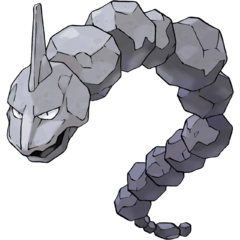
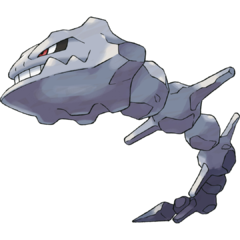
Onix is a massive snake with a body formed of ten or more stony segments. It is found underground and in caves in many parts of the world. However, as impressive as it may look, in terms of gameplay its only good stat is Defense and its type combination leaves it with a ton of weaknesses. It evolves into Steelix, a massive snake whose stone portions have turned to a metallic armor due to compression and iron ingested through soil and rocks it consumes over many years (trading a captured Onix holding a Metal Coat will evolve it right away). It often lives even deeper underground than Onix. Steelix isn't by any means the strongest Ground or Steel type out there, but it can still be a force to be reckoned with, combining a usable Attack stat with monstrous Defense. In Omega Ruby and Alpha Sapphire, Steelix gained a Mega Evolution with Sand Force.
- Adaptational Badass: In the anime, it's usually depicted as being just as powerful as one would think it'd be.
- Armored But Frail: Onix has an excellent base 160 Defense, but a very poor base 35 HP and 45 Special Defense, giving it a weakness to moves that bypass physical defense. Its typing definitely doesn't help either.
- Body to Jewel: Mega Steelix has had parts of its body crystallize. Given that lore states Onix becomes Steelix as a result of pressurization, it would seem that Mega Steelix has undergone further compression to become part diamond.
- Boss Battle: Both Onix and Steelix. Onix is the first gym boss of Gen I (and by extension, the first boss of the entire series), being Brock's signature Mon. Steelix is Jasmine's signature, she being the sixth gym leader of Johto/Gen II.
- Crippling Overspecialization:
- Onix has the second-highest Defense of any Gen I 'Mon, but that's by far its only good stat — aside from its below-average speed, everything else is on par with unevolved Com Mons like Rattata. It gets much better upon becoming Steelix.
- Before the Sturdy ability Onix has got its Balance Buff in Pokémon Black and White guaranteeing a Last Chance Hit Point against any attack that would wipe out Onix in one turn (of which there are quite a few), it only worked against four specific One-Hit Kill attacks: Horn Drill, Guillotine, Fissure, and Sheer Cold.
- Discard and Draw: Upon evolving into Steelix, it trades its Rock-type for Steel.
- Dishing Out Dirt: Onix is a Rock and Ground-type. Steelix loses Rock in favour of Steel, but keeps Ground.
- Extra-ore-dinary: Steelix drops the Rock-typing to become part Steel.
- Fake Ultimate Mook: Onix was the former trope namer as "Level 5 Onix". Despite being a 28-foot snake covered in solid rock, its only notable stats are 160 base Defense and a subpar 70 Speed; everything else is pathetic. Your unevolved starter Pokémon can hit harder than it and has more HP; once it evolves, it'll surpass Onix in likely every way except Defense. For a direct comparison, Rattata, the definitive Com Mon, both hits harder than Onix and moves faster than it, and has almost as much HP.
- Fire, Ice, Lightning: Steelix learns Fire Fang, Ice Fang, and Thunder Fang naturally (though you need the Move Relearner to get at them).
- The Giant: The Onix evolution group is among the largest Pokémon in the franchise so far. In fact, they were the largest Pokémon at their time and Onix remains as the largest unevolved one. Paradoxically, the Onix line is one of the very few lines where regular specimens can be both bigger and heavier than its Alpha Pokémon counterpart in Legends: Arceus.
- Kill It with Water: They're both weak to Water-type moves, especially Onix.
- Last Chance Hit Point: Their Sturdy Ability, which lets them survive any attack from full health with 1 HP remaining.
- Long-Lived: Steelix's Dex entries imply that Onix can live for at least a century if not more.
- Magically Inept Fighter: Steelix has okay Attack, but poor Special Attack, which remains after it turns into Mega Steelix and gains 125 base Attack.
- Mighty Glacier: Mega Steelix keeps the very low Speed, while at the same time rivaling Shuckle and Mega Aggron for the highest Defense in the game. It also has great Attack and a very good offensive ability in Sand Force, which raises the power of Ground, Rock, and Steel moves in a Sandstorm.
- Mutagenic Food: Onix feeds on the earth it tunnels through, making it something more like a rock-worm rather than a rock-snake. Steelix is theorized to have evolved from Onix accumulating iron ore from the dirt it eats over the course of 100 years.
- Orbiting Particle Shield: Mega Steelix has thin shards of crystal orbit its head.
- Our Dragons Are Different: They may draw inspiration from the wyrm, since they naturally learn Dragonbreath.
- Segmented Serpent: Both Onix and Steelix's bodies look like they're made out of individual boulders linked together. This is usually purely aesthetic, but in the original Pokémon Ranger, Steelix fights exactly like this trope would imply.
- Shed Armor, Gain Speed: Onix's Hidden Ability is Weak Armor, which causes physical attacks against it to reduce its Defense while increasing its Speed (though its terrible HP makes this strategy questionable). Their naturally-learned Rock Polish can also help with this.
- Signature Move: Steelix is strongly associated with the move Iron Tail. While many others can learn it with the TM, and Steelix needed the TM to at first, Steelix is the only one that has STAB with it in Generation II. In VIII, it is the only one that can learn it naturally in base Sword and Shield.
- Silicon-Based Life: Onix is a living rock snake while Steelix is a living steel snake.
- Socialization Bonus: Needs to be traded to evolve. However, in some games, Steelix can be a rare wild encounter and even an in-game trade.
- Status Infliction Attack: Potentially defied by Steelix's Sheer Force Ability. Any attack it uses that can induce one of these will forgo that chance in favor of dealing additional damage instead. Even better, it learns all three elemental fang attacks, all of which fall in this category.
- Stone Wall: Onix's only decent stats are Defense and Speed, while everything else approaches Sunkern-level bad. Steelix's Attack, while better, is still quite average without Mega Evolving.
- Super Mode: Steelix gains a Mega Evolution in Omega Ruby and Alpha Sapphire. It gets a decent boost to its Attack, Defense, and Special Defense stats to become a more effective Mighty Glacier and the ability Sand Force to increase the damage of its Ground, Rock, and Steel attacks during Sandstorms.
- Useless Useful Spell: The family gets Rototiller as an egg move. Considering the amount of chain-breeding needed to get an Onix with the move (Lopunny to Cacnea to Paras to Dwebble to Onix), all it does is raise the attack stats of all Grass-types on the field, which can be lethal to Onix itself.
- Warm-Up Boss:
- Onix's terrible stats across the board except for defense are arguably a relic of it being the Signature Mon of the franchise's first Gym Leader. As the first boss, it looks and feels like a challenge to overcome for Com Mons that only have weak physical moves, but doesn't hit back that hard itself, so even new and young players have a good chance to win.
- Downplayed in FireRed and LeafGreen, as while it still has its mostly poor stats it also possesses Rock Tomb, a 50 base power Rock-type move that has STAB and lowers Speed (in Generation One Onix didn't have any Rock-type moves as Brock's mon, its strongest attack being the Normal-type Bide), making it a dangerous threat to Charmander and Butterfree, and a more imposing challenge to other Pokémon.
- Weak to Magic: Onix and Steelix have high Defense but poor Special Defense, though Mega Steelix manages to boost its Special Defense enough to avoid this.
- Weather Manipulation: Both learn Sandstorm naturally, which is helpful for patching up Onix's iffy Special Defense, this is also a major boon for Mega Steelix whose ability Sand Force requires Sandstorms to naturally boost its Steel, Ground, and Rock-type attacks.
0096: Drowzee / Sleepe (スリープ suriipu)
0097: Hypno / Sleeper (スリーパー suriipaa)
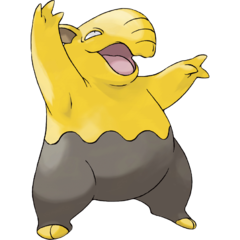
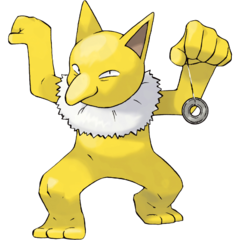
Those who didn't have the luck or patience to capture Abra would have to settle for this Pokémon instead. These Pokémon love eating dreams and are willing to put anyone to sleep just to sample their dreams. Unfortunately, this habit made them earn a seedy reputation, especially since most of their targets for dream-eating and hypnotizing are children.
- Ambiguously Evil:
- It's hard to tell if the Hypno species is genuinely evil or if they are amoral like any other animal/Pokémon. It's worth noting that Hypno are not registered as Dark-type themselves. The ambiguity of the dex entries could just as easily imply that the child was found or was safely returned, rather than just abducted and never found. So the phrasing of the Pokédex entries may have blown the whole thing out of proportion.FireRed Pokédex Entry: It carries a pendulum-like device. There once was an incident in which it took away a child it hypnotized.
- The Ultra Sun entry implies Hypno only targets humans out of desperation when they can't subsist themselves off of Pokémon dreams. They primarily target Komala in Alola because that species of Pokémon spends its entire lifetime asleep.Ultra Sun Pokédex Entry: In Alola, Komala is Hypno's main target. It rarely harms people.
- In the games, Hypno can only learn "Dream Eater" through a TM, not by training or by leveling up. So that wild Hypno either belonged to a trainer or was released at some point before hypnotizing the missing child. Alternatively, this could mean that the way it normally eats dreams in the wild is different from the move Dream Eater, which deals damage and is explicitly made for combat.
- Although Hypno is registered as extremely dangerous, trainers (both in the game and the anime) aren't really afraid of Hypno despite the incident and generally approach with caution when they are seen in the wild, suggesting the incident was dismissed once they got a better understanding of the Pokémon's behavior.
- In the Lostelle incident in Leafgreen, there are multiple signs telling travelers to be wary of Pokémon in the area who are looking for berries. Lostelle simply strayed too far from the path and Hypno found her by chance. It wasn't trying to abduct her, it just wanted the berries.
- It's hard to tell if the Hypno species is genuinely evil or if they are amoral like any other animal/Pokémon. It's worth noting that Hypno are not registered as Dark-type themselves. The ambiguity of the dex entries could just as easily imply that the child was found or was safely returned, rather than just abducted and never found. So the phrasing of the Pokédex entries may have blown the whole thing out of proportion.
- Bad Powers, Good People: The Hypno Pokémon are not registered as dark-type Pokémon and the child abduction incident was largely dismissed as a cautionary tale rather than a horrifying incident. In later Pokédex entries, it's stated that Hypno is often used to treat sleep disorders and help their trainers go to sleep.Sun Pokédex Entry: While it is an extremely dangerous Pokémon, people who are in need of a good, sound sleep call it their savior.
- Baku: Drowzee (and by extension its evolution, Hypno) are bipedal tapir-like Pokémon best known for eating dreams. Drowzee's Sun Dex entry mentions that they're believed to share common ancestry with the also tapir-based Munna line introduced in Unova.
- Blue-and-Orange Morality: They have a habit of hypnotizing people who stare at them for too long, it's never made clear if they do this maliciously or if they were punished for acting on their instinct to hypnotize targets for their dreams. At one point, a Hypno abducted a child after hypnotizing them, but the series would never provide context about what happened. This mentality would explain why Hypno is not listed as Dark-type Pokémon and why the series would go on to have future Pokédex entries explaining how Hypno can be used as a treatment for sleep disorders.
- Stadium Pokédex Entry: If you lock eyes with it, it will try to hypnotize you. It is best to close your eyes quickly before you get hypnotized.Ultra Moon Pokédex Entry: There are some Hypno that assist doctors with patients who can't sleep at night in hospitals.
- Boss Battle:
- Hypno is Aether Branch Chief Faba's strongest Pokémon.
- An outlaw Drowzee is also the first real boss of Pokémon Mystery Dungeon: Explorers.
- Combat Pragmatist: Even though they aren’t Dark-types. They aren't hesitant at all to use their prowess in hypnosis against opponents.
- Confusion Fu: Not so much in the main games, but in Pokémon GO, it's one of the few Pokémon with access to all three elemental punches, which makes it risky to not shield against its charge moves lest it runs something to instantly take out an opposing mon.
- Dream Stealer: They feed off of people's dreams, though Hypno's Ultra Sun Dex entry mentions that in Alola they primarily go after Komala instead, presumably because they're always sleeping.
- Fractured Fairy Tale: The Baku is usually portrayed as a benevolent spirit that is welcomed for its tendency to eat nightmares and evil spirits. Drowzee and Hypno's dream-eating, however, is frequently played for horror.
- Gag Nose: Both of them have rather large noses — Drowzee in particular has one resembling a tapir's trunk, and Hypno's is that of a proboscis monkey's honker.
- Hanlon's Razor:
- The lost child incident has left the Hypno line in infamy for abducting children, and taking them away to consume their dreams. However, the series and pokédex entries would go on to imply that the incident wasn't as malicious as the audience was led to believe. In Hypno's Naptime, it's said that Hypnos can generate sleep waves to put their target to sleep. When Hypnosis is altered to affect humans, children are sensitive to these sleep waves and it caused the children of HopHopHop Town to believe they were Pokémon as a side effect. In the game, trainers are warned not to stare too long at Hypno if they are encountered in the wild, implying that the lost child simply stared too long at a Hypno and was hypnotised.FireRed Pokédex Entry: It carries a pendulum-like device. There once was an incident in which it took away a child it hypnotized.Stadium Pokédex Entry: If you lock eyes with it, it will try to hypnotize you. It is best to close your eyes quickly before you get hypnotized.Ultra Sun Pokédex Entry: In Alola, Komala is Hypno's main target. It rarely harms people.
- In the Lostelle incident in Leafgreen, there are multiple signs telling travelers to be wary of Pokémon in the area who are looking for berries. This Hypno wasn't trying to abduct a child, it was just hungry and found Lostelle and the protagonist by chance.
- The lost child incident has left the Hypno line in infamy for abducting children, and taking them away to consume their dreams. However, the series and pokédex entries would go on to imply that the incident wasn't as malicious as the audience was led to believe. In Hypno's Naptime, it's said that Hypnos can generate sleep waves to put their target to sleep. When Hypnosis is altered to affect humans, children are sensitive to these sleep waves and it caused the children of HopHopHop Town to believe they were Pokémon as a side effect. In the game, trainers are warned not to stare too long at Hypno if they are encountered in the wild, implying that the lost child simply stared too long at a Hypno and was hypnotised.
- Hypno Pendulum: Hypno uses a pendulum to hypnotize people.
- Non-Malicious Monster: It's clear from some of their entries that they don't really intend any harm in their search for desirable dreams to eat, but that doesn't detract from how much of a ruckus they can cause, their disturbing powers and the way they use them, or how some trained individuals are used for villainous purposes. For example, the Pokédex entry for Ultra Moon states that they work in hospitals to help treat people who are having difficulty sleeping. The anime also shows a Pokémon club using a Hypno to treat insomnia.
- Obliviously Evil: The Hypno species feed on dreams and rely on hypnotism to put their target to sleep. However, one Hypno abducted a child, either by accident or on purpose, and it was blamed for acting on its instincts. Either way, it's generally advised that trainers approach with caution and not stare too long at Hypno, otherwise they'll get hypnotized too. It's really worth noting that Hypno isn't listed as a Dark-type Pokémon, implying that they aren't aware that their hypnotism is pretty dangerous and would bring unwanted attention if they abduct trainers.
- Once Done, Never Forgotten: In the games, one Hypno managed to take a child away after hypnotizing them and it's now made the entire species infamous for abducting children. In FireRed and LeafGreen, this happens again in the post-game and the player has to fend off a single Hypno to save Lostelle. Bad apples really do spoil the bunch for these species of Pokémon.X Pokédex Entry: It carries a pendulum-like device. There once was an incident in which it took away a child it hypnotized.
- Psychic Powers: Both of them are Psychic-types specializing in hypnotism.
- Resistant to Magic: Special Defense is their only above average stat.
- Signature Move: Dream Eater, despite not learning the move naturally. Hypnosis, which they do learn naturally, qualifies as well.
- Status Buff: Its ability to learn Nasty Plot gives it at least one offensive advantage over Alakazam.
- Status Infliction Attack: Apart from the obvious hypnosis, they learn Poison Gas naturally for some unexplained reason.
- Stone Wall: They become this starting in Generation II, when their Special Attack received a considerable drop thanks to the Special split.
- Unwitting Instigator of Doom: Their powers of hypnotism are very dangerous and it led to the abduction of a child, with no further information or context on how or why it happened. The dex entries never reveal if the child returned or disappeared forever.
- Would Hurt a Child: It's known that Hypno likes to kidnap children and brainwash them with hypnosis so they can eat their dreams; the Fire Red and X Pokédex entries mention that one individual did exactly this. What isn't helping is that Drowzee prior, according to the Silver/Soul Silver entries, specifically has more fondness for children's dreams than adults’. In Fire Red/Leaf Green's post-game story, a Hypno outright attacks Lostelle (a little girl) in a forest on the Sevii Islands. In fact, the aforementioned attack on one of the Sevii Islands is a sidequest where the player intervenes to rescue the Hypno's target, and it was mentioned on an episode of the original Pokémon series.
- You Have Researched Breathing: Their diet is made up of the dreams of other beings. The only way they can learn Dream Eater is by TM, and that is arguably the reason behind said move being a TM consistently across generations.
- Youkai: They're based on the Baku, spirits who devour dreams.
0098: Krabby / Crab (クラブ kurabu)
0099: Kingler (キングラー kinguraa)
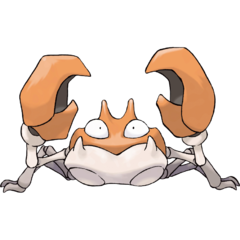

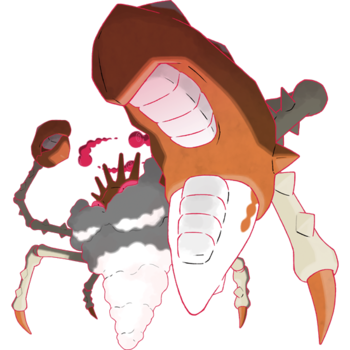
A special Kingler caught in a Raid Battle in Galar has the ability to Gigantamax, which gives it access to G-Max Foam Burst, a Water-type damaging move that harshly reduces the speed of opponents.
- Armored But Frail: High 115 base Defense, but a pitiful 55 base HP means that moves that can can circumvent its defenses make short work of it.
- Awesome, but Impractical: Many of Kingler's Pokédex entries mention how its giant claw, while good at crushing things, is also ludicrously heavy.
- Balance Buff: The Physical/Special split in Gen IV allowed them to use their huge attack stat in conjunction with its STAB. Its signature move Crabhammer was also changed from special to a physical move.
- Cool Crown: Kingler, as its name suggests, has spikes on its head that resemble a crown.
- Critical Hit:
- Its Shell Armor Ability allows it to avoid these.
- On the other side, its Secret Art of Crabhammer has an increased chance to inflict one.
- Dishing Out Dirt:
- An indirect example in its naturally-learned Mud Sport, which reduces the damage it takes from Electric attacks to one-third, thus reducing its weaknesses to one.
- Does less well in regards to attacks; Mud Shot runs off of its poor Special Attack, and Dig is often too predictable to bother with. On the other hand, it has access to Rock Tomb and Rock Slide, useful attacks that both benefit from Sheer Force.
- Divergent Character Evolution: Unlike most copycat species, Kingler and Crawdaunt have steadily been made more dissimilar playwise, but still maintain a Foil relationship and are each perfectly viable. Kingler has Agility while Crawdaunt has Dragon Dance (and both get Swords Dance); Kingler has the Sheer Force ability while Crawdaunt has Adaptability; Kingler is primarily physically focused with higher base speed, while Crawdaunt is a bit slower and more fragile in exchange for enough Special Attack to run mixed movepools.
- Exactly What It Says on the Tin: Krabby's Japanese name, as seen above.
- Giant Enemy Crab: Kingler weighs 132 lbs/60 kg. The trope is played up even more when Kingler is Gigantamaxed, as it's more than 62 feet tall.
- Lightning Bruiser: It's actually not that slow, so one good use of Agility (which it can be bred with) will give it very respectable Speed.
- Making a Splash: Both are Water-type crabs that can curiously be found both in fresh and saltwater bodies.
- Mighty Glacier: Not speedy, but hits hard and can take a beating itself. Of course, it learns a number of moves that can reduce its opponent's Speed, including Bubble, Bubble Beam, Mud Shot, Icy Wind, and Rock Tomb.
- One-Hit KO: Naturally learns Guillotine.
- Powerful, but Inaccurate: Kingler's large pincer has massive crushing power, but is so heavy that it's difficult to aim. According to the Pokédex, at least; Kingler's accuracy is no worse than that of any other Pokémon in-game. However, this does accurately describe its One-Hit KO Guillotine move, which is known as "Pincer Guillotine" in the original Japanese and only learned by it and Pinsir in Gen I.
- Power Pincers: Kingler's left claw in particular is massive.
- Power Up Letdown: Gigantamax Kingler has its damaging Water-type moves replaced by G-Max Foam Burst, which deals damage and also reduces the speed of opposing Pokémon. The added effect is decent, but Max Geyser sets up rain, which increases the damage of Water-type moves, on top of Kingler already being able to use Agility to patch up its speed. Still, it can at least slow opponents down for other team members if Kingler isn't able to finish the job.
- Red Eyes, Take Warning: Gigantamax Kingler has red eyes, and has a claw capable of pulverizing anything combined with strongly alkaline bubbles that quickly melt anything hit by them.
- Red Live Lobster: They are crabs that are reddish-orange.
- Right Hand of Doom: Its left claw is an exaggeration of the real-life fiddler crab's oversized claw.
- Secret Art: Crabhammer, albeit no longer exclusive since Gen III. Fittingly, it has only been shared with other crustacean-based Pokémon.
- Shown Their Work: Gigantamax Kingler's foamy beard is based on the phenomenon where land-dwelling crabs produce bubbles as part of their breathing process, or as an answer to predators.
- Status Buff: Gets a lot of these, actually. Swords Dance, Iron Defense, Agility, Amnesia, Double Team, Hone Claws… just about the only stat it can't boost is Special Attack.
- Status-Buff Dispel: It can be bred with Haze, allowing it to negate all active Status Buffs.
- Status Infliction Attack: Defied by its Hidden Ability of Sheer Force. Any attacks that would have a chance of inflicting a status effect forgoes that chance in favor of boosted power (and the potential to boost them even further with the Life Orb item without suffering recoil damage).
- Super Mode: Gains the ability to Gigantamax in Pokémon Sword and Shield, which replaces any damaging Water-type moves with the move G-Max Foam Burst, while also giving it a Weird Beard made of foam and also switches its design to one heavily reminiscent of the japanese spider crab.
- Useless Useful Spell: Crabhammer was this prior to Generation IV due to being a Special attack, which made it very weak coming from Kingler's less-than-impressive Special Attack stat.
- Weak to Magic: Kingler has high physical Defense, but has a poor base 50 Special Defense.
0100: Voltorb / Biriridama (ビリリダマ biriridama)
0101: Electrode / Marumine (マルマイン marumain)
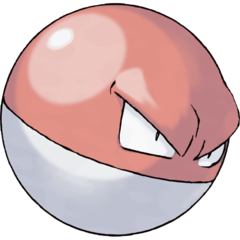
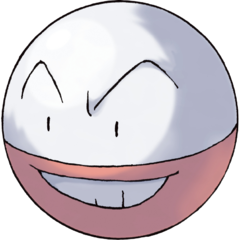
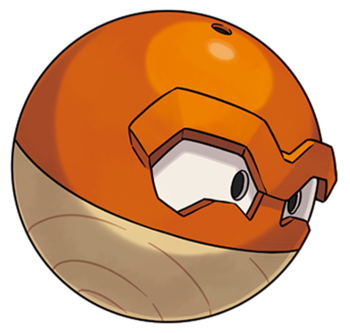
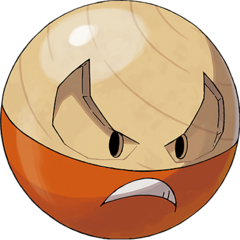
Electric-type Pokémon that look like Poké Balls. They probably have the simplest design in the series. Since their game sprites resemble item sprites, unsuspecting adventurers will get a nasty shock when they find that what they thought was an item is actually an angry Pokémon that's prone to exploding. It was once known as the fastest Pokémon in the game, and is still only surpassed by Speed Forme Deoxys, Ninjask, Pheromosa, and Regieleki.
Voltorb has an Electric/Grass Hisuian Forme, which resembles an ancient Apricorn Ball rather than its modern Poké Ball design. Contrary to its poor-tempered modern counterpart, Hisuian Voltorbs are described as being very amicable creatures, although its friendliness causes it to unwittingly electrocute people and Pokémon alike.
- Action Bomb: They tend to explode at the slightest provocation. This comes into play in-game by it naturally learning Self Destruct and Explosion, as well as having Aftermath as an ability.
- Angry Eyebrows: Well-known for constantly sporting these no matter what mood they're in, going hand in hand with their Hair-Trigger Temper. Its Hisuian Forme has a slightly different eyebrow shape that makes it look much cheerier.
- Balance Buff: Gen VII made the line even faster — by 10 points.
- Boss Battle: Hisuian Electrode serves as a Noble Pokémon in Legends: Arceus.
- Cheshire Cat Grin: Probably because it's always itching to ruin your day with Explosion.
- Chest Monster: Look like Poké Balls on the overworld, which contain items. Checking them leads to a battle. Even with the change in item appearances in Legends: Arceus, they have a chance of appearing inside shaking chests in the higher portions of Coronet Highlands.
- Early-Installment Weirdness:
- Voltorb and Electrode were both yellow in the handheld gen 1 games, before being changed to red in the anime and all future games.
- For the first two Generations, the line couldn't learn any Electric-Type moves by levelling up.
- Eye Pop: Electrode's fainting animation in the console games.
- Fixed Damage Attack: A rare user of Sonic Boom.
- Fragile Speedster: Electrode is a very fast Pokémon, but its offensive and defensive stats are rather sub-par.
- Glass Cannon: With Electro Ball in play, and even moreso with boosts from Charge Beam and Charge.
- Green Thumb: Hisuian Voltorb are part Grass-type and contain countless seeds.
- Hair-Trigger Temper: Voltorbs and Electrodes are infamously short-tempered and will discharge their energy at the slightest provocation.
- It Amused Me: According to the Pokédex, one of the reasons Electrode tend to blow themselves up is just to amuse themselves when they're bored.
- Keet: Hisuian Voltorb are very happy and friendly, but they tend to accidentally discharge all their stored electricity from the hole on their head if they get even a little bit excited, shocking nearby humans and other Pokémon. They are also very easy to excite. This has proved problematic to humans, who have been said to treat Voltorb as a nuisance and kick it out of their settlements after temporarily plugging the hole on top of its head.
- Mechanical Lifeforms: Said to have first appeared near a factory that made Pokéballs, and are one of the few mons that qualify as this trope that aren't Steel-type, unlike their fellow mechanical compatriot Magnemite.
- No Biological Sex: Both Voltorb and Electrode are genderless.
- No Mouth: Voltorb lacks a mouth, but gets one upon evolution.
- Permanently Missable Content: In the Alola games, the line can only be obtained without transferring from a previous generation by catching Electrode as a Chest Monster in Team Rocket's Castle in Pokémon Ultra Sun and Ultra Moon. However, there are only three of them, they don't respawn, and the area vanishes after completing Episode RR, taking any unfought Electrode with it.
- Perpetual Frowner: Contrasting its Kantonian counterpart, Hisuian Electrode has a painted-on frown that never changes.
- Perpetual Smiler: Electrode wears a constant smirk in all of its game sprites.
- Piñata Enemy: Not normally, but there is a section in the Team Rocket HQ in Gold/Silver and their remakes where you can very easily grind a large number of Geodude, Voltorb, and Koffing, which will usually Self-Destruct. Bring a Ghost-type you've been meaning to train and... free levels, yay!
- Poor, Predictable Rock: Well-known for having a terrible movepool, especially among Gen I Pokémon. Even worse, most of the different-typed moves it gets (Gyro Ball, Sucker Punch, Rollout) run off of its shabby Physical attack stat, in addition to being poorly suited to Electrode's playstyle (as mentioned below).
- Riddle for the Ages: Their Pokédex entries and NPCs speculate on where they came from or note the mystery of their origins and nature, as the modern form at least was first discovered only after Poké Balls became mass produced. Are they experiments gone wrong? Mutated Pokéballs? Poké Balls mutated by an experiment gone wrong? No one seems to know. Hisuian Electrode's dex entry suggests that they are made of Apricorns or early Apricorn-based Poké Balls, but still doesn't answer the question of what their relation to either is.
- Secret Art: Hiusian Electrode gets exclusive access to Chloroblast, a Grass-type variant of Steel Beam (deals heavy damage and costs the user half its max HP, rounded up).
- Shock and Awe: Both are Electric-types.
- Signature Move: The most well-known users of Self-Destruct and Explosion, thanks to the anime; if only they had the attack power to back it up...
- Status Infliction Attack: Its Static Ability can inflict paralysis on opponents that physically strike it. In addition, its high Speed but poor attacking stats lead most players to have it cripple opponents with Thunder Waves before they can react.
- Support Party Member: Electrode has mediocre attacking stats and defenses, but extremely fast speed and access to a few useful support moves, such as Thunder Wave, Reflect/Light Screen, and Helping Hand. It can also learn Volt Switch (and, of course, Explosion) to get your other Pokémon into battle without losing a turn.
- Units Not to Scale: Voltorb are four times the size of a regular Poké Ball, and Electrode are even larger, yet they appear as regular Poké Balls on the world map.
- Useless Useful Spell: A lot of the attacks it can use are pointless on it, even when ignoring its poor physical Attack. Gyro Ball requires the user to be slower than its opponent to do much, which isn't likely to happen with Electrode. Sucker Punch is similarly pointless, given how Electrode is likely to outrun just about everything anyway. Rollout requires several consecutive hits to build its power to destructive levels, which isn't likely to happen with a Fragile Speedster like Electrode. As for Explosion, it's surprisingly easy to survive given Electrode's poor Attack.
- Yōkai: Voltorb is strongly based on Tsukumogami
 , an inanimate object that received a soul after a century of use (which issupported by Voltorb's National Dex number being 100). Voltorb and Electrode lack the additional typing of Ghost, however.
, an inanimate object that received a soul after a century of use (which issupported by Voltorb's National Dex number being 100). Voltorb and Electrode lack the additional typing of Ghost, however.
0102: Exeggcute / Tamatama (タマタマ tamatama)
0103: Exeggutor / Nassy (ナッシー nasshii)
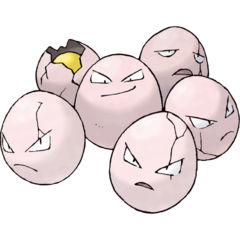
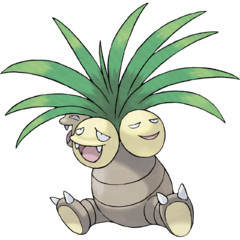
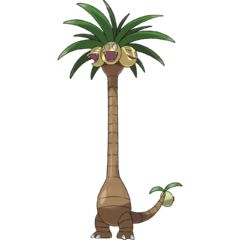
Exeggcute is a clutch of what appears to be six cracked/broken eggs with faces on them (actually plant seeds), each with distinctive expressions. Despite this, they all constitute a single Pokémon, linked together by telepathy. They evolve together to form Exeggutor, a coconut tree with legs and 3 coconut heads, courtesy of the Leaf Stone.
In the Alola region, a unique form of Exeggutor are found. Due to the year-long tropical sun, they grow incredibly tall, up to 35 ft, making them the third-tallest non-Legendary Pokémon known. Alolan Exeggutor also have a fourth head on its tail, which is useful for protecting itself from threats close to the ground. Alolan Exeggutor are Grass/Dragon instead of Grass/Psychic.
- A Head at Each End: Alolan Exeggutor sport an additional head on their tails.
- Arch-Enemy: Exeggcute's main predator in Alola is Crabrawler, which they fend off with Psychic-type attacks.
- Balance Buff: Generation VII gave Exeggutor a small buff to its Special Defense.
- Crouching Moron, Hidden Badass: Despite looking rather clumsy, Exeggutor is very efficient in terms of stats, with a base stat total that rivals Aegislash, Chandelure, Flygon, and Starmie, among others.
- Continuity Nod: It's stated in Generation III Pokédex entries that Exeggutor originally hails from the tropics; four generations later, it's stated that Alolan Exeggutor is believed to be the natural state of Exeggutor, the "default" form having stunted growth due to living in a habitat not able to meet their nutritional needs. Long-necked Exeggutor have been sparsely depicted in other Pokémon media; most prominently in the Pocket Monsters manga where Red's Clefairy had angered one after mistaking it for an actual coconut tree and hurting one of its heads trying to remove it.
- Depending on the Writer: It's rather unclear as to whether Exeggcute are actually eggs, or just seeds that happen to look like eggs. Pokédex entries seem to flip flop back and forth on this.
- The Dividual: The individual eggs all act as a single Pokémon. It isn't easy to tell the eggs apart, but at least one has an exposed yolk and another has a face with a glum expression instead of an angry one.
- Early Installment Character-Design Difference: Exeggcute's first sprite had one of its eggs much larger than the other five. In later sprites, all six eggs are the same size. Exeggutor's back sprites up until Gen IV featured a head facing the player, suggesting it actually had 4 heads. Later gens removed the back head, definitely giving it 3 heads as the Pokédex states.
- Egg Folk: Zigzagged with Exeggcute. While it is referred to as the egg Pokémon with a few Pokédex entries saying that it is a group of sentient eggs, with some even looking to be eggs with cracks, it also has some entries pointing out how it has properties of seeds.
- Fighting Clown: Alolan Exeggutor are very goofy-looking in appearance, and are ridiculously tall, so much so that their heads cannot be seen during battle, but make no mistake, they are part Dragon.
- Gameplay and Story Segregation: According to Exeggcute's Ultra Moon Dex entry, while Alolan Exeggcute are the same size as Exeggcute elsewhere, they're much heavier, though in-game there's not much of a difference.
- Gold Makes Everything Shiny: Exeggcute's shiny look. Justified as it's a visual pun on the story of the goose that laid the golden egg.
- Green Thumb: Grass-type, despite being a group of eggs in its base form.
- Hive Mind: Six distinct seeds form an individual Exeggcute, though Pokédex data suggests that individual members of an Exeggcute can and do exist, usually looking for a group.
- Kryptonite Is Everywhere:
- The family has 7 weaknesses in total, giving it the most weaknesses out of all Pokémon, though it's also tied with Rock/Dark, Rock/Fighting, Grass/Dark (all as of Generation VI), and Ice/Grass.
- Alolan Exeggutor loses weaknesses to Fire, Dark, and Ghost, and its Bug weakness becomes less severe, but it gains weaknesses to Dragon and Fairy in return, for a total of 6 weaknesses, including a double weakness to Ice-type moves.
- Lightning Bruiser: Exeggutor can become one if it uses Sunny Day to activate Chlorophyll.
- Logical Weakness: Alolan Exeggutor have a double weakness to Ice, which is fitting for a Pokémon variety found in a tropical area. And while not applicable to gameplay, their lore notes that their long necks, while making a good weapon to swing at foes, are vulnerable targets for opponents.
- Long Neck: Alolan Exeggutor are incredibly tall. 35 ft. Most of it is a long neck trunk.
- Magic Knight: Alolan Exeggutor have a better physical attack stat than normal Exeggutor and a wider physical movepool to work with, including strong coverage moves like Earthquake, Dragon Hammer, and Brick Break. However, they're still weighted towards the special end of the spectrum.
- Magikarp Power: Exeggcute has very low stats overall, with its only decent one being its Defense. Exeggutor, on the other hand, is very strong to decent in every way but Speed.
- Mighty Glacier: Exeggutor has a monstrous Special Attack stat (among Grass types, only Roserade matches it), rather good HP, and decent defenses, but it's rather slow. Its Attack stat is pretty good too, and can have Curse bred onto it to boost both that and its Defense, making it even more of a Mighty Glacier (its physical movepool isn't great, though). This was especially so in Gen 1, where it effectively had a massive 125 Special Defense, making it resilient to even super-effective special hits. Then Alolan Exeggutor are even slower than their mainland cousins, although they receive a slight boost to their physical attack stats to compensate.
- Multiple Head Case: Exeggutor grow coconut heads that eventually fall off and find other fallen heads to form an Exeggcute. Alolan Exeggutor take this even further by growing heads on their tails.
- Nerf: Exeggutor was one of the biggest victims of Gen 2's Special stat split, where Exeggutor's base Special Defense was reduced by a massive 60 points, leaving it at rather meager 65, which was especially a problem when Exeggutor is so slow and needs to be able to take hits. Generation VII would later buff its Special Defense to a slightly stronger 75, though still a far cry from what it was in Gen 1. This significant direct nerf, alongside Exeggutor's weaknesses (particularly the Bug type) becoming more prominent and general Power Creep, led to Exeggutor going from one of the very best Pokémon in competitive play during Gen 1 to irrelevant competitively in modern Gens.
- Non-Damaging Status Infliction Attack: Exeggcute learns the Poison Powder/Stun Spore/Sleep Powder trio. Exeggutor learns Hypnosis, though Sleep Powder is inherently better due to its greater reliability and better accuracy (Sleep Powder has always been 75% while Hypnosis was 70% in Diamond/Pearl, and 60% everywhere else). The only saving grace for Hypnosis is that, as of Gen VI, Sleep Powder is no longer able to put Grass-types to sleep while Hypnosis can.
- Our Dragons Are Different: Alolan Exeggutor are Dragon-types, despite not resembling traditional dragons of any sort. This may be a reference to the Dracaena plant, also known as the "dragon tree", which Alolan Exeggutor resemble.
- Our Monsters Are Weird: Six egg-shaped seeds with random bruises, cracks, and holes in them (plus faces on all six of them) which can turn into a giant pineapple-tree hybrid with three coconut heads — and both of these forms have psychic powers. How it makes sense is beyond anyone's understanding. The Alola region's Exeggutor are even weirder in that instead of Psychic-types, they're Dragon-types and have exceptionally long necks and tails with a fourth head at the tip of the tail, similar to Girafarig.
- Perpetual Smiler: Exeggutor is almost never seen without a smile on each of its three heads.
- Playing with Fire: In keeping with its draconic heritage, Alolan Exeggutor can learn Flamethrower — useful for getting the drop on those pesky Ice-types.
- Psychic Powers: Exeggcute and non-Alolan Exeggutor are part Psychic-type, though according to Alolan Exeggutor's Shield Dex entry for "Isle of Armor" their fourth head can use a weak telepathy to scan the area around it despite losing the Psychic-type upon evolution.
- Pun-Based Creature: Alolan Exeggutor is a Grass/Dragon type that looks like a tall palm tree... or a dracaena plant, whose name means "female dragon" in Greek.
- Secret Art: Barrage. This move involves throwing small objects at the opponent. Alolan Exeggutor can also learn Dragon Hammer upon evolution, though it's no longer unique to it, as the Ultra games also allowed Tropius to learn it.
- Similar Squad: The Rival's answer to the Bulbasaur line in the Gen I games and their remakes if he doesn't have one. It's appropriately the strongest Grass-type of Gen I by base stat total, and has an advantage over most others that are part Poison.
- Status Buff: Their Hidden Ability "Harvest" effectively gives unlimited berries.
- Stealth Pun: Exeggcute is an egg plant.
- Exeggutor is a palm tree whose fruits have faces on them. Exeggutor is a facepalm!
- Alolan Exeggutor gets a Dragon typing, as in Dragonfruit.
- Stuff Blowing Up: Learns Egg Bomb, Seed Bomb, and Explosion.
- Telepathy: The six egg-like seeds making up Exeggcute communicate with each other via telepathy.
- Underground Monkey: The exceedingly tropical climate of Alola produced an Exeggutor of titanic proportions.
- Use Your Head: Dragon Hammer has Exeggutor swing its entire upper body onto the foe. When you're a good 35 feet tall, that's gotta hurt.
- When All You Have Is a Hammer…: Dragon Hammer is the only Dragon-type move that Alolan Exeggutor learns through level-up, and is appropriately named to boot.
- When Trees Attack: Standard Exeggutor somewhat resembles a coconut tree, but Alolan Exeggutor is very clearly based on one with its long, trunk-like neck.
- Wolverine Publicity: Its Alolan form was heavily promoted after its reveal in Sun/Moon, but in the game itself, it doesn't really get much screentime, being available at the very last island and is not used by any opposing trainers.
- Youkai: Exeggutor is based off the jinmenju, an obscure tree-like youkai with human heads for flowers.
0104: Cubone / Karakara (カラカラ karakara)
0105: Marowak / Garagara (ガラガラ garagara)
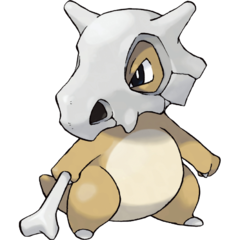
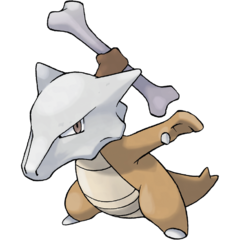

These Pokémon resemble dinosaurs that wear skulls as helmets. In Cubone's case, the skull it wears is that of its dead mother, and the stains on it are the poor creature's tears as it cries for its long-gone mommy. This made sense back in Gen I when breeding didn't exist. Starting with Gen II and the introduction of breeding, the story has been called into question, since Cubone can be bred complete with the skull and with no ill effects on the mother, so it might be an urban legend. Either way, Marowak is still a badass. Especially when holding a Thick Club.
In the Alola region, due to pressures from Grass-type predators, the Marowak have learned to harness fire by lighting their bones with their skulls like matches, and they've developed a sixth sense to sense the presence of danger, becoming Fire/Ghost-types. They have darker skin and appear to be a bit lankier as well. They also have a vendetta against Mandibuzz, who prey on young Cubone.
- Astonishingly Appropriate Appearance: Alolan Marowak have light green flames on either side of their bone clubs, giving them the appearance of a Hawaiian fire dancer.
- Bad with the Bone: Their weapon of choice is a femur bone, which Sun and Moon reveals comes from their deceased mothers. They have a few attacks that take advantage of this and most of them are moves that only this family can learn.
- Balance Buff: The introduction of their signature Thick Club item in Gen 2 made them far more effective in battle.
- Battle Baton: Alolan Marowak uses its bone club as a fire baton, and Kiawe's trial features a group of Alolan Marowak showing off their baton-twirling skills.
- Combat Pragmatist: Marowak is addressed as such (despite not being a Dark-type, as Dark-types didn't come until later and it wasn't retconned like Magnemite and Magneton were), being weak but using bones as weapons.
- Continuity Nod:
- Alolan Marowak's Ghost typing is likely a reference to Marowak's role in the story of the Generation I games, especially considering the flavor text referencing their mother's vengeful protecting spirit.
- The Fire-type and more specifically the use of Alolan Marowak's bone as a spinning torch invokes the Polynesian dancer motif used by Phoebe of Pokémon Ruby and Sapphire, who specialized in Ghost-types.
- Cool Helmet: Cubone wears the skull of its deceased mother as a helmet. The skull fuses to its face when it evolves into Marowak.
- Damn You, Muscle Memory!: Alolan Marowak has the Rock Head ability just like Cubone and other Marowak do, but it's programmed into a different slot, being its hidden ability instead. This can cause players quite a surprise as Rock Head Cubone evolves into Cursed Body Alolan Marowak, and Battle Armor Cubone evolves into Rock Head Alolan Marowak.
- Dem Bones: The stock skeleton monster to go along with Gastly as the stock ghost monster in the Big Boo's Haunt Lavender Tower stage. Instead of literally being skeletons, however, the family wears skulls to give themselves a menacing appearance, and Alolan Marowak even has matching skeleton markings on its back. They're also very good at wielding bones as weaponry and even have an item that only they can use called the Thick Club, which doubles their attack stat.
- Discard and Draw: Upon evolving into Alolan Marowak, Cubone ditches its Ground-type completely in favor of Fire/Ghost, giving it a completely different set of resistances and weaknesses.
- Dishing Out Dirt: Cubone and most Marowak are Ground-types. Ironically, the moves which involve them throwing their bone (Bone Club, Bonemerang, and Bone Rush) are also Ground-type and thus can't hit Flying-type Pokémon, no matter what the 'dex wants you to believe.
- Due to the Dead: Alolan Marowak mourn and bury their dead as a custom.
- Early-Installment Weirdness:
- The Marowak that shows up in the Pokémon Tower is an actual ghost of a deceased being, not a Ghost-like-yet-living creature like the various Ghost-types. Nothing like it showed in the mainline games for a long time (Legends Arceus briefly shows the ghost of a deceased Hisuian Arcanine who still watches over his child).
- Most Pokémon aside from Legendaries and Mythicals, especially in later generations, are conceived as entire species instead of individual characters. Cubone was conceived as a specific individual: a child whose parent was murdered by Team Rocket. This has created a race of Inexplicably Identical Individuals whose mothers have all been killed by Team Rocket which patently makes no sense. Fans have attempted to resolve this by insisting that the Cubone/Marowak Pokémon species just use the bones of many different ancestors but there's yet to be an official retcon to resolve the contradiction. An official animated adaptation that depicts Cubone's mother being killed even shows that the Cubone already has the skull helmet while she is still alive. As of Sun and Moon, this seems to have been rectified by the having the parents presumably be killed off by Mandibuzz.
- Forever War: Sun and Moon reveals that Cubone are the preferred prey of Mandibuzz, which are attracted to the sound of their crying. Marowak spend their time hunting Mandibuzz to take revenge.
- From Nobody to Nightmare: Possible overlap with Who's Laughing Now?. Historically, the species was known for being weak and preyed upon — until they figured out that they could use bones as weapons. Then there's the whole "Cubone's mother dies and goes from crying over it to becoming a Roaring Rampage of Revenge" story…
- Game-Breaking Bug: Victim of one in Generation II, where a max Attack Marowak with a Thick Club that used Swords Dance would hit the Attack cap and wrap around to very low Attack.
- Gameplay and Story Segregation: Later games continue to describe it as wearing the skull of its dead mother. This includes any Cubone that the player has obtained via breeding, so it's very possible for said dead mother to still be alive and well.
- Ghostly Animals: In addition to its Alolan form, which is a ghost type, a Marowak (which is based on dinosaurs) appears as a ghost in Lavender Tower in Gen I and its remakes.
- Guardian Entity: In Gen I, the literal ghost of a Marowak is a vengeful spirit protecting her baby Cubone. For Alolan Marowak, it is said that the spirit of their mothers empower their bones to defend them even in death.
- Heal the Cutie: Cubone is famous for grieving the death of its mother. However, according to the Pokédex in Pokémon Ruby and Sapphire, it evolves into Marowak when it overcomes its sadness and grows tough.
- Homing Projectile: The fireballs that Alolan Marowak conjure will pursue their targets until they strike.
- An Ice Person: The line can inexplicably learn Ice Beam and Blizzard though TMs (making Alolan Marowak one of the very few Fire-types to be capable of using Ice-type moves), though they can't use them well due to their poor Special Attack.
- Informed Ability: The Sun and Moon Pokédex entries mention Alolan Marowak using their Bonemerang attack to knock Mandibuzz out of the sky. As a Ground-type attack, Bonemerang has no effect on the Flying-type Mandibuzz under normal circumstances.
- King Mook: A Totem Alolan Marowak appears in the trial of Wela Volcano Park in Pokémon Ultra Sun and Ultra Moon, replacing Salazzle.
- Lean and Mean: Alolan Marowak are thinner than the stocky Ground-type Marowak and have a more sinister appearance as well. To be precise, regular Marowak weigh about 99.2 lbs, while Alolan Marowak average at 74.9 lbs.
- Lighter and Softer: At least one anime special rewrote Cubone's "Lonely" moniker as down to it having an aloof, selfish attitude, ignoring its game's dex entry entirely.
- Magic Fire: The cursed flames on Alolan Marowak's bone are said to be formed from their mother's spirit, cause mental and physical pain that will never fade, and will always burn no matter the amount of water used on them.
- Mighty Glacier: Marowak's not too fast, but with a Thick Club, it can hit like a Mack truck, essentially having Huge Power as an item giving it roughly 210 base attack and has 110 base defense. Alolan Marowak plays up the defensive portion of this trope, with its typing plus Lightning Rod giving it a whopping 10 resistances and immunities — more than half the types in the game and the most of any non-Steel-type 'mon.
- My Parents Are Dead: Almost every one of Cubone's Pokédex entries has to bring up its dead mother, and that it wears her skull for a helmet. In one of the entries, it even says that Cubone cries whenever it sees the likeness of its mother in the full moon.
- Not Completely Useless: While Lightning Rod sounds useless for a Pokémon that has low Special Attack and being outright immune to Electric attacks in the regular form's case, Lightning Rod does redirect Electric-type moves in Double and Triple battles, allowing Marowak to redirect said attacks away from any teammates who might be weak to it. Alolan Marowak also appreciates it much more than normal Marowak, as it is otherwise neutral to Electric, and Lightning Rod adds to its already impressive list of resistances and immunities. This is reinforced in prior to Generation V where Lightning Rod did not provide immunity to Electric-type moves, so being naturally immune provided completely safe redirection of any Electric-type attacks.
- Playing with Fire: Unlike the majority of the world's Marowak, Alolan Marowak are part Fire type. All Marowak are capable of using Fire-type moves like Flamethrower or Fire Punch.
- The Power of Love: Alolan Marowak gained their sixth sense through their great care for their partners.
- Punny Name: Marowak = Marrow + Whack. It whacks enemies with a marrow-filled bone.
- Revenge: One of their Pokédex entries mention that once Cubone strengthens its resolve, it evolves into Marowak in order to get revenge on those who killed its mother. The Sun and Moon entries also state that after evolving, they hunt Mandibuzz out of revenge since Mandibuzz prey on Cubones.
- Secret Art: Bone Club and Bonemerang are Ground-type moves that only Cubone and Marowak can learn. Both of them take advantage of the bones that they wield as weapons. Bone Rush was another bone-based move that was also exclusive to them until Gen IV, when Lucario can also learn it. Alolan Marowak gains the Ghost-type Shadow Bone, which may debuff a target's Defense.
- Shock and Awe: Alolan Marowak is capable of learning Thunderbolt and Thunder.
- Skeletons in the Coat Closet: Cubone wears the skull of its dead mother.
- Soul Power: Alolan Marowak are part Ghost-type.
- Stock Femur Bone: The one they're holding.
- Technicolor Fire: Alolan Marowak have bone clubs whose ends are covered in light green flames.
- Underground Monkey: Alolan Marowak are different from Marowak elsewhere by being Fire/Ghost types. They evolve from seemingly ordinary Ground-typed Cubone.
- The Unreveal: Outside of a few illustrations of questionable canonicity, Cubone has never been seen without the skull on its head.
- Weaksauce Weakness: While no Pokémon will much appreciate having its item removed, this line is particularly vulnerable to the very common Knock Off, which will halve its damage output in one fell swoop assuming it holds the Thick Club (it almost always does). This goes double for Alolan Marowak, which is additionally weak to the damage component of the move (Alolan Marowak is part-Ghost and Knock Off is Dark).
- Wound That Will Not Heal: It's said that the flames from Alolan Marowak's bone can cause physical and mental wounds that will never heal.
- You Killed My Mother: Saddened by the death of its mother according to the Pokédex, regular Marowak in desert terrains specifically direct their rage at the Mandibuzz who prey on them.
0236: Tyrogue / Balkie (バルキー barukii)
0106: Hitmonlee / Sawamular (サワムラー sawamuraa)
0107: Hitmonchan / Ebiwalar (エビワラー ebiwaraa)
0237: Hitmontop / Kapoerer (カポエラー kapoeraa)
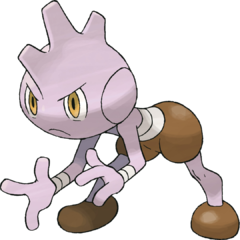
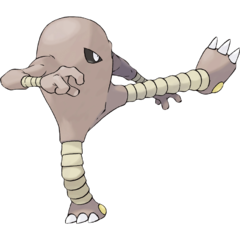
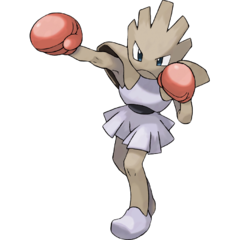

In Gen I, when you defeated the Karate King in the Fighting Dojo, you were given a choice between two fighting Pokémon: Hitmonlee, who specializes in kicking attacks, and Hitmonchan, who specializes in punching attacks. Both these Pokémon seemed to be related, but didn't evolve into one another. That changed with Gen II when they introduced Tyrogue, a fighting type that didn't seem to specialize in anything — yet. They need to be trained in a certain stat to evolve into Hitmonlee (higher attack), Hitmonchan (higher defense), or the new third member, Hitmontop, who specializes in spinning on his head (their attack and defense stats are even).
- Action Initiative: All of them can learn Mach Punch, Bullet Punch, Fake Out, and Vacuum Wave (though they're much less effective with that last one). Hitmontop is even one of the rare few with both the Technician ability and a priority move they can get STAB with. Additionally, Hitmonlee and Hitmontop can get Sucker Punch from Gen IV Move Tutors, though Hitmonchan can't learn it.
- All Your Powers Combined: Being an all-male line with three possible evolutions, this group has the distinction of having breedable moves, but only from the line's other forms. This leads to any one of these Pokémon being able to learn and combine the moves of all three of them on one moveset.
- Armored But Frail: All of the Hitmons have good special defense stats at 110, but a pitifully low 50 base HP. Hitmonchan's Pokédex entry notes that it needs to rest after fighting for just three minutes, suggesting that their lack of stamina applies both in-universe and out.
- Balance Buff:
- Gen II's special stat split came with a 75 point Special Defense buff.
- Gen IV brought the physical/special split. Now all of Hitmonchan's Elemental Punches run off his Attack and not Special Attack, making them considerably better.
- Bare-Fisted Monk: Hitmonchan, being a punching specialist, is the most notable example, though all of them qualify.
- Boxing Battler: Hitmonchan, with his Red Boxing Gloves and boxing techniques.
- Confusion Fu: Hitmonchan, Hitmonlee, and Hitmontop have very diverse movepools, with access to boosting moves like Bulk Up and Agility, utility like Rapid Spin and Fake Out, and all three of the elemental punches. Hitmontop and Hitmonlee also both have multiple very useful abilities, with Intimidate and Technician in the former case and Unburden and Reckless in the latter.
- Dance Battler: Hitmontop is a Fighting-type based on breakdancing and capoeira.
- Death or Glory Attack: Hitmonlee's High Jump Kick. With the boost from Reckless, Hitmonlee has one of the hardest-hitting High Jump Kicks in the game. Of course, if Hitmonlee misses, he crashes, taking half of the damage he would've dealt himself.
- Determinator: Tyrogue's Pokédex entries state "it keeps on fighting even if it loses." Fittingly, it gets the Guts ability, which boosts attack if it's burdened with a status ailment.
- Disability Superpower:
- Tyrogue can have the Guts ability, which boosts Attack if they're afflicted by a Status Effect.
- Both Tyrogue and Hitmontop can have Steadfast, which increases their Speed if they flinch.
- Early Installment Character-Design Difference: In early games and media, Hitmonlee had Tsurime Eyes to match the outline of the body's eye holes. In most later appearances, they are just small round ones.
- Elemental Punch:
- Hitmonchan can learn all of the Elemental Punch attacks in the games.
- Hitmonlee can also learn Blaze Kick.
- Extremity Extremist: Hitmonchan mainly attacks with punches, Hitmonlee mainly attacks with kicks. Hitmonchan takes it further, though, as the Iron Fist ability specifically boosts punching attacks.
- Fragile Speedster: Hitmonlee is the fastest of the three and has the lowest Defense stat, although 87 Speed isn't that impressive compare to other Fragile Speedsters. Their Hidden Ability, Unburden, helps somewhat, as it doubles speed after losing or using a held item. One strategy is to give Hitmonlee a Normal Gem and use Fake Out, using up the Normal Gem and activating Unburden.
- Gameplay and Story Integration:
- In Hitmontop's Crystal Dex entry, it's mentioned that it can spin so fast it can drill a hole in the ground, and it can learn Dig by TM and (starting in Sword and Shield) via level up.
- Hitmontop's Ruby and Sapphire Dex entry states that its fighting style of spinning on its head is "a remarkable mix of both offense and defense at the same time". Sure enough, it evolves from a Tyrogue whose Attack and Defense are equal, and its own stats in both are equal.
- Glass Cannon: Hitmonlee has the highest Attack, but the worst Defense of the three. The other two aren't much sturdier, though, with their horribly low base 50 HP, though they at least have high Special Defense. Even more so in the first generation, where Hitmonlee and Hitmonchan's Special were their modern Special Attack — that is to say, really, really low. As in, 35. It didn't take very much to KO those two guys.
- Hu Mons: The Tyrogue line plays with this trope. Tyrogue itself resembles a martial arts trainee with purple skin and brown shorts, but its evolutions vary in their resemblance to humans. Hitmonchan closely resembles a human boxer, having red boxing gloves as well as a purple tunic, kilt, and pair of "shoes". Hitmontop has a more deformed appearance, as it primarily resembles a top, but it's still fairly human-like. Meanwhile, Hitmonlee barely resembles a human, looking more like a sack with long arms and feet.
- Hurricane Kick: Hitmonlee and Hitmontop both learn their own spinning kicks (Rolling Kick for Hitmonlee, Triple Kick for Hitmontop), though the former is more of a roundhouse.
- Jack of All Stats: Hitmonchan qualifies for this, having a stat distribution that's more offensive than Hitmontop but more defensive than Hitmonlee.
- Magikarp Power: Tyrogue is a contender for being one of the weakest Pokémon, with all stats at 35 and a limited level-up movepool of essentially Tackle, Fake Out, Foresight, and Helping Hand (outside of breeding). Once it evolves into any of the three, it becomes much more powerful, though still relatively weak by fully-evolved Pokémon standards.
- Master of None: Tyrogue has a rather low value of 35 in all his stats.
- Mighty Glacier: Hitmontop has a decent Attack stat, a reasonable Defense, and the usual high Special Defense, but is the slowest of the three evolutions.
- Minidress of Power: The fact that they're all male doesn't stop Hitmonchan from wearing one.
- Missing Secret: In X and Y, Tyrogue has Ally Switch as an Egg Move, even though none of its evolutions can learn it (and for most male-only species, this is the only way a move could be passed down); it was removed in Omega Ruby and Alpha Sapphire. Although the move has been since reintroduced as Move Tutor and a Technical Record with better availability, none of the Hitmons can be taught the move.
- Named After Somebody Famous: Hitmonlee and Hitmonchan are named after Bruce Lee and Jackie Chan. Their Japanese names Ebiwalarnote and Sawamular note are named after Japanese martial arts stars. Hitmonchan's French name is Tygnon, after Mike Tyson.
- No Mouth: Hitmonlee.
- Odd Name Out: Unlike Hitmonlee and Hitmonchan, who are named after famous martial artists, Hitmontop is named after... a top. Its Japanese name isn't much better at it is named after the martial arts capoeira.
- One-Gender Race: All of them are always male.
- Power Up Letdown:
- Downplayed with Hitmonchan. While Iron Fist is Hitmonchan's main claim to fame, and makes all his punch moves hit far harder, the immunity to flinching provided by Inner Focus can be useful. Even moreso when the ability blocks Intimidate starting from Gen VIII.
- Painfully played straight with Hitmontop, though. Immunity to flinching will always be better than a situational speed increase, and Top's other two abilities are extremely potent and consistent.
- Entirely averted with Hitmonlee, who gets Unburden to aid his sweeping capabilities.
- Rapid-Fire Fisticuffs: Hitmonchan's Pokédex entries claim that they deliver volleys of punches too fast for humans to see. They start off with Comet Punch so that it comes into play in-game.
- Red Boxing Gloves: Hitmonchan (or blue, if shiny).
- Resistant to Magic: All three Hitmons have a respectable 110 Special Defense, even Hitmonlee, who is otherwise a Glass Cannon. In the case of Hitmonchan and Hitmontop, it's actually their best stat, despite what appearances would suggest.
- Rubber Man: Hitmonlee has springy legs that allow it to run faster and kick from farther away.
- Sarashi: Tyrogue have markings on their bodies that look like they are wrapped with white cloth.
- Secret Art:
- Hitmonlee was the only Pokémon able to learn Mega Kick via level up until Gen VII, and was the only Pokémon able to learn High Jump Kick until Gen III and Jump Kick until Gen IV. Hitmonchan remains associated with Mega Punch (one of 3 Pokémon to learn it via level up), the elemental punches (only Pokémon able to learn all 3 in Gen I, and one out of 2 to learn each one), and Mach Punch (only one to be able to learn it in Gen II). Hitmontop gets Triple Kick. The line as a whole had Rolling Kick until Gen VII, which was exclusive to Hitmonlee in Gen I, but grew to include Hitmontop as well in Gen II.
- Shout-Out Theme Naming: In both the original and English, in fact. Hitmonlee is Tadashi Sawamura
 /Bruce Lee while Hitmonchan is Hiroyuki Ebihara
/Bruce Lee while Hitmonchan is Hiroyuki Ebihara /Jackie Chan. In fact, Hitmonchan's entry in a Japan-exclusive official Pokédex strongly hints at his being possessed by Ebihara's spirit (Ebihara died in 1991, when Pokémon was in its early stages of development).
/Jackie Chan. In fact, Hitmonchan's entry in a Japan-exclusive official Pokédex strongly hints at his being possessed by Ebihara's spirit (Ebihara died in 1991, when Pokémon was in its early stages of development). - Spectacular Spinning: Hitmontop revolves around this, as a reference to breakdancing and the real-world martial art of Capoeira. Additionally, both Hitmontop and Hitmonlee have access to the move Rolling Kick.
- Spin to Deflect Stuff: Thanks to breeding, all of them are capable of learning Rapid Spin, which gets rid of entry hazards on the user's side.
- Stealth Pun: Tyrogue evolves into Hitmontop when he has a balance of attack and defense. Hitmontop balances on his head.
- Useless Useful Skill: Hitmonchan's elemental punches. While versatile, they were nearly useless in Gen I because of Hitmonchan's horrible Special stat. This was fixed in Gen IV when the attacks all became physical.
- Weak, but Skilled: Invoked by Hitmontop's Technician, which not only boosts all of its priority moves, but also Rapid Spin, Aerial Ace, Thief, Bulldoze, and Triple Axel, all of which have 60 or lower BP.
0108: Lickitung / Beroringa (ベロリンガ beroringa)
0463: Lickilicky / Berobelt (ベロベルト beroberuto)


Lickitung is a weird lizard-like Pokémon known for having a very long and sticky tongue, reminiscent of a chameleon or a skink. It had a pretty wide movepool, but it wasn't spectacular. It was never common (it was only available via an in-game trade back in Gen I) and it was largely ignored. However, in Gen IV, it gained a new evolution that had the stats to utilize its impressive movepool. It can learn Explosion, made more powerful via STAB.
- Action Bomb: Lickilicky is occasionally used for its absurdly strong Explosion, being the only mons with STAB on the move. It can destroy anything that isn't a Rock, Steel, or Ghost type (and a few things that are), but it makes Lickilicky faint.
- Big Eater: Uses its 6 foot tongue to eat.
- Cartoon Creature: Lickitung is a... thing somewhat reminiscent of salamanders with an extremely long tongue and tail, which may also reference the akaname, a yokai that cleans the filth on bathhouses.
- Confusion Fu: Like several Normal-types, it has quite an arsenal of various elemental attacks, and its Attack and Special Attack are close enough that it could work with either with equal effectiveness (though it does have fewer options for boosting its Special Attack).
- Crouching Moron, Hidden Badass: The line has surprisingly good stats and a reasonable movepool, in spite of its outright weird appearance.
- Early-Installment Weirdness: Lickitung was not able to learn Lick in the original games; indeed, the only moves it learned by level-up that could be seen as remotely tongue-related were Wrap and Slam.
- Mighty Glacier: Great HP, good defenses, and reasonably usable offensive stats on both sides. Speed? Not so much. Invoked by Curse, which makes it stronger and sturdier, but also slower, and possibly lampshaded in that wild Lickitung have a chance of holding a Lagging Tail, an item that forces its holder to move last.
- Multipurpose Tongue: With such a long tongue, the Lickitung line is one of the few users of Power Whip that isn't a plant-based Pokémon.
- Non-Elemental: Both are Normal-types.
- Our Monsters Are Weird: Look at them!
- Overly-Long Tongue: Nearly 7 feet long for Lickitung. With Lickilicky, the record for the longest tongue on one is more than 82 feet — roughly fifteen times the size of Lickilicky itself.
- Power Up Letdown: Downplayed. Cloud Nine is a situational hidden ability, but Oblivious and Own Tempo equally, or even more so. It became the case, however, as Oblivious was later buffed in Gen VI to prevent Taunt from working - which is a blessing given the line's status-based playstyle - and Own Tempo was buffed in Gen VIII to block Intimidate, aiding physical sweeping sets, leaving Cloud Nine woefully behind.
- Retcon: In Gen IV, Lickitung became able to evolve into Lickilicky by leveling up while knowing Rollout, a move it could already learn in earlier generations.
- Status Buff: Quite a few good ones, actually. It's among the rare few to get Belly Drum and Amnesia, can be bred with Curse to bolster its Mighty Glacier status, or can get either Swords Dance or Work Up to just boost its offense.
- Support Party Member: Gets a few, yet potent supporting moves like Wish, Heal Bell, Knock-Off, Dragon Tail and all the weather moves except Hail.
- Useless Useful Spell: Naturally learns Me First, which is a move that requires the user to move before the opponent to do anything. Look at its stats and guess why it's a not very useful move.
- Vine Tentacles: Naturally learns Power Whip. Naturally learning Wring Out could also count.
- Weather Manipulation: Its Hidden Ability is Cloud Nine, which negates all effects of weather while its out. It can also learn all the weather generating moves with the exception of Hail.
- You Have Researched Breathing: Lickitung could not learn Lick until Gen II. Averted in later generations, where Lickitung does actually start out with the move.
- Youkai: Both have similar characteristics to the Akaname
 , possessing a very long tongue and in most depictions being able to produce an almost endless amount of saliva and having a single clawed foot. Their pink coloration also brings to mind and contrasts somewhat with the primarily red coloration that the Akaname is famous for, the name literally translating to red filth.
, possessing a very long tongue and in most depictions being able to produce an almost endless amount of saliva and having a single clawed foot. Their pink coloration also brings to mind and contrasts somewhat with the primarily red coloration that the Akaname is famous for, the name literally translating to red filth.
0109: Koffing / Dogars (ドガース dogaasu)
0110: Weezing / Matadogas (マタドガス matadogasu)

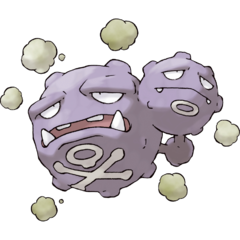
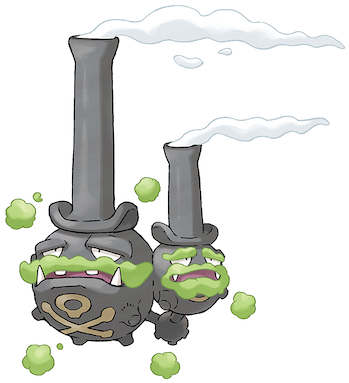
Koffing and Weezing are strange Pokémon with origins that are hard to pinpoint. It might be the living manifestation of smog, or it might be a levitating Sea Mine. Either way, it's a very good defensive wall, with only a single weakness (once abilities came about in Gen III) and a high defense.
Weezing spotted in Galar exhibit Fairy-type attributes and consume the toxins in the air they breathe, cleaning the atmosphere as a result; some clouds of this material take on the form of moustaches, and they are adorned with hat-like smokestacks. They originally became this form during a time when factories choked the air with pollution, and Koffing and Weezing were far more common. While still Poison-types, they're noted to have less potent toxins than their Kantonian counterparts.
- Action Bomb: Learns Self-Destruct and Explosion.
- Ambidextrous Sprite: Weezing's big and small heads would switch sides in the sprite based games. In-universe, this is explained by Weezing being able to inflate and deflate each of its heads at will.
- Animal Facial Hair: Galarian Weezing's smoke forms a moustache on the larger head and a full beard on the smaller one. This combined with the smokestack top hats make Galarian Weezing resemble a 19th century factory owner.
- Boss Battle: Weezing is the fifth (or sixth) gym boss, being Koga's signature in Gen I.
- Crouching Moron, Hidden Badass: Though not exactly a "moron" unless you consider its role in the anime, you probably wouldn't guess at first that Weezing has a base stat total of 490, the same as Electabuzz and Kangaskhan, among other heavy hitters. It also has a larger movepool than you might expect, too, including Shadow Ball, Flamethrower, and Thunderbolt.
- Deadly Gas: Emits this with Poison Gas and Smog.
- The Eeyore: Weezing looks like it's always miserable. In fact, it's possible for it to have a complete moveset of attacks which either only activate when Weezing is knocked out, or cause it to faint outright.
- Foil: Primarily to the Grimer and Muk line.
- The gaseous Koffing and Weezing have low HP but high Defense and good mixed attacking stats, which contrast with the liquid sludge Grimer and Muk who have higher HP, good Attack and Special Defense, but lower Defense and Special Attack.
- In Omega Ruby and Ultra Sun and Moon, Weezing is given to Team Magma's Maxie to further contrast Team Aqua's Archie, who uses Muk.
- Both lines were given a regional variant where they acquire a different type. In this case, Galarian Weezing acquires the Fairy type, which contrasts with Alolan Grimer and Muk's Dark type.
- Rounding out the two lines is the land based pollution Pokémon in Garbodor, introduced in Gen V, which is more balanced in terms of its stats.
- Home Field Advantage: Galarian Weezing's hidden ability is Misty Surge, the same as Tapu Fini, which creates Misty Terrain upon entering the battlefield.
- Inconsistent Spelling: Since Koffing's Japanese name uses the same katakana as the second half of Weezing's name, it's been spelled as either "Dogas" or "Dogars". "Dogars" appears to be the correct spelling, as evidenced by Roxie's song in the Japanese Pokémon Black 2 and White 2 version of Virbank Gym (which merely spells Koffing's Japanese name over and over) including an "R" in the lyrics.
- Light 'em Up: Galarian Weezing can learn Dazzling Gleam via TR.
- Living Gasbag: It might be this. In the anime, it's depicted as being a solid rock full of gas, but the games suggest that it's more flexible than that — perhaps too flexible, seeing as it sometimes "overinflates its round body and explodes".
- Mighty Glacier: Fair offensive stats, great Defense, and Kantonian Weezing has only one weakness thanks to Levitate, but pitiful Speed and HP.
- Mini-Me: One of Weezing's "heads" is a lot smaller than the other one, like a seperate identical Pokémon that got fused onto it.
- Muck Monster: Like the Grimer family, they are animated waste, but as a variant based on polluted gas. Koffing and regular Weezing also gain Stench as a hidden ability.
- Multiple Head Case: Weezing, although the two heads are conjoined. According to a few Pokédex profiles, there are occasionally three-headed Weezings.
- Our Fairies Are Different: Galarian Weezing are Fairy-type Pokémon, though they don't resemble "typical" fairies at all, even other Fairy-types in the Pokémon setting: they're not conventionally cute or particularly impish and lack any pink coloration that the Fairy type is associated with.
- Oxymoronic Being: Galarian Weezing's Poison/Fairy typing is rather unusual, considering Fairy-types are weak to poison.
- Perpetual Frowner: Both forms of Weezing look like they're never in a good mood.
- Perpetual Smiler: Koffing looks like it's always in a good mood.
- Piñata Enemy: Not normally, but there is a section in the Team Rocket HQ in Gold/Silver and their remakes where you can very easily grind a large number of Geodude, Voltorb, and Koffing, which will usually Self-Destruct. Bring a Ghost-type you've been meaning to train and... free levels, yay!
- Playing with Fire: Being made entirely out of explosive gases, both Koffing and Weezing can learn various Fire-type moves via TM/TR. Weezing (both variants) can learn Heat Wave naturally in Gen VIII.
- Poisonous Person: Poison-type. The Galarian version of Weezing are also Fairy-type, and can still weaponize their undigested toxins.
- Power Nullifier: Koffing and all Weezing's second ability is Neutralizing Gas, an ability that cancels out other Pokémon abilities.
- Power Up Letdown:
- Kantonian Weezing have Stench as a Hidden Ability. Weezing not only has two natural and fantastic abilities to use, it is also a Mighty Glacier which means that it won't be flinching anything a good number of times.
- Galarian Weezing have the hidden ability Misty Surge. Immunity to status for grounded Pokémon is rather nice, except that half, or most of Weezing's utility is the ability to use Will-O-Wisp, Toxic and Toxic Spikes, with opposing Pokémon now being immune to all of those for 5 turns.
- Quintessential British Gentleman: Galarian Weezing bears a distinct resemblance to one, with its tall "hats" and mustache.
- Recurring Element: Although not until Generation V; Koffing forms a Poison-typed parody of the Land, Sea, Sky triumvirate with Grimer and Trubbish, in that they represent three distinctive forms of pollution. Koffing, specifically, are the Air Pollution Pokémon, representing toxic fumes, industrial air pollutants, smog, and other airborne chemical nastiness. In addition, they're also the second pure-Poison family to gain a regional form with a secondary typing (the first being Grimer and Muk), although only Weezing, not Koffing, has a regional form.
- Rock Monster: The line look like living meteorites. Ones that spew out poisonous gas.
- Secret Art: Smog, pre-Generation IV (although Flareon was able to learn it in Gen I as well). Gen VIII gave the line Neutralizing Gas, an Ability that fully cancels out the Abilities of all other Pokémon while they're present on the battlefieldnote . Galarian Weezing can also have the move Strange Steam, which has the chance to inflict confusion, though a visit to the move relearner is required in order to obtain it.
- Signature Move: Most commonly associated with Smog.
- Solid Gold Poop: Galarian Weezing ingest airborne contaminants and excrete clean air. At least something good came out of Galar's pollution problems.
- Suicide Attack: Can learn Self-Destruct, Explosion, and Memento (the latter doesn't deal damage but instead reduces the target's attacking stats).
- Take That!: Their beta English names were NY and LA. New York and Los Angeles are two cities infamous for their pollution problems.
- Taking You with Me: Learns Destiny Bond, which takes down any enemy that knocks Weezing out.
- Technicolor Toxin: They are shades of purple to make it more obvious that they are Poison-type Pokémon. Though the actual toxic gasses they produce is usually more of a shade of yellow.
- Underground Monkey: In Galar, the native Weezing are grey in color and produce green smoke. They also happen to be Poison/Fairy.
- Useless Useful Spell: Galarian Weezing can learn Misty Terrain and have Misty Surge as a hidden ability, but the condition is counterproductive in a line whose main selling point is the ability to spam status conditions.
- Visual Pun: Galarian Weezing have literal stovepipe hats.
- Walking Wasteland: It stores several toxic gases in its body. Inverted with Galarian Weezing, which actually cleans the air as it goes around.
- Weak to Magic: With only 65 HP and 70 Special Defense, this is in effect for Weezing.
- You Have Researched Breathing: Couldn't learn Poison Gas until Gen 2, despite being the Poison Gas Pokémon.
0111: Rhyhorn / Sihorn (サイホーン saihoon)
0112: Rhydon / Sidon (サイドン saidon)
0464: Rhyperior / Dosidon (ドサイドン dosaidon)

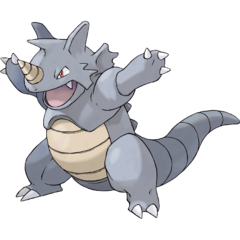
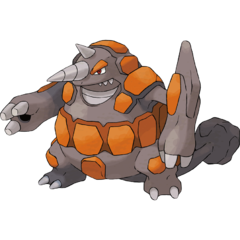
Rhyhorn and Rhydon vaguely resemble rhinoceros or ceratopsian dinosaurs. It's a great physical Pokémon, but its special stats and speed are rather lacking. Its nose horn may draw electrical attacks to it, but luckily, it's immune to the damage due to being a Ground-type (except for in the anime). Rhydon has the distinction of being the first Pokémon ever designed and coded into the game. Rhyperior is basically Rhydon on steroids; it's even chunkier than before, and it's now gained some armor in the form of orange rocks which reduce super-effective damage by a quarter.
- Achilles' Heel: Grass and Water-type moves are the entire line's bane. Ironically, the last two are able to learn Surf, a Water-type move.
- Arm Cannon: Rhyperior has gaps in its palms that function as these to shoot rocks, and depending on region the occasional Geodude or Roggenrola.
- Ascended Meme: Rhydon having the Lightning Rod ability, after the infamous moment in the anime where Pikachu defeated a Rhydon by aiming electricity at its horn.
- Boss Battle: All three of them, believe it or not:
- Rhyhorn is Giovanni's strongest Mon in his gym battle during the remakes of the Generation I games.
- Rhydon, on the other hand, is Giovanni's strongest in his gym battle of Gen I.
- Rhyperior is Bertha's signature in her Elite Four Battle in Platinum.
- In Pokémon Ranger: Shadows of Almia, Rhyperior is used by Heath during your third battle against him.
- Clingy Costume: Rhypherior's orange belt-looking ornament highly resembles the Protector it must hold when trading in order to evolve.
- The Computer Is a Cheating Bastard: For some reason, Brock's Rhyhorn in HeartGold and SoulSilver has Sturdy as an ability, despite the fact that the line never had the ability before or since.
- Confusion Fu: While not as varied, due to its poor Special Attack stat, Rhyhorn and its evolutions have an incredibly diverse movepool, and can use every element but Psychic and Fairy in one form or another.
- Dishing Out Dirt: Ground and Rock-type. Notably, this line is the only line with this type combo to have Ground as the primary type.
- The Ditz: Rhyhorn is said to be so dumb that it has rocks for brains and can charge into a brick wall and not feel any pain until the next day. Rhydon is said to be smarter, though still forgetful.
- Dumb Muscle: Rhyhorn comes off as this, being really strong but not very intelligent.
- Four Legs Good, Two Legs Better: Rhyhorn is stated to not be very bright. Rhydon is said to be smarter due to standing on two legs.
- Gameplay and Story Integration:
- Rhyhorn's Pokédex entries often talk of how they tend to charge straight ahead until they forget why they're charging in the first place. In Pokémon Sword and Shield, Rhyhorn in the overworld are notable for charging straight ahead at the player if within their line of sight, but not chasing after the player like other hostile Pokémon. A charging Rhyhorn can be easily dodged by stepping to the side and, indeed, they will continue charging straight for quite a distance until they stop.
- Some of Rhydon's entries also talk about how it can survive in molten lava. Sure enough, in Mystery Dungeon games, starting with Pokémon Mystery Dungeon: Explorers, it and its evolution are one of the few non-Fire types that can walk on lava without getting burned.
- Magically Inept Fighter: While the line has a surprisingly large variety of special moves they can learn, they can't use any of them effectively due to the line's poor Special Attack. Their Special Defense is also rather horrible, ensuring that any special Water or Grass attack is almost guaranteed to knock them out instantly.
- Mighty Glacier: Slow, but high Attack and Defense, though their Special Defense is terrible. Taken even further for Rhyhorn and Rhydon when given Eviolite, which increases their extremely high Defense to a level very close to the literal Mighty Glacier, Avalugg, and boosts their Special Defense to merely below-average.
- Not Completely Useless: The Lightning Rod ability might come into play if Soak is used, but every Pokémon that can learn that move also learn moves that are super-effective against the Rhyhorn line's natural dual-typing. However, Lightning Rod also has the effect of drawing away Electric-type attacks from allies in Double and Triple Battles, so they can be paired with a Pokémon that is vulnerable to Electric-type attacks (like Gyarados) to keep those attacks from utterly destroying them. As with the example mentioned with Marowak above, Lightning Rod prior to Generation V did not providing immunity to Electric-type attacks allows for safe redirection of Electric-type attacks unlike other holders of the ability that aren't Ground-type such as Manectric who will resist but otherwise still take damage.
- Power Up Letdown: Rhyperior's Hidden Ability, Reckless, which boosts the power of recoil moves by 20%. Rhyperior learns a whole two moves with this effect, and both of them are Normal-type. Overall a disappointment compared to the far more useful Solid Rock.
- Power-Up Mount: In Pokémon X and Y, a Rhyhorn can be ridden on in Route 9. It can also break boulders. The Rhyhorn outside of the player's home can also be ridden on, but it won't go any further than your doorstep.
- Rhino Rampage: Rhyhorn will charge straight ahead (no matter what — or who — is in its path) and only stop when it either hits a wall or forgets why it's charging in the first place.
- Rock Monster: All of them are part Rock-type, while Rhyhorn and Rhyperior at least look like rhinos that are made out of stone. Not too much Rhydon, though.
- Secret Art: Rock Wrecker for Rhyperior, although no longer exclusive as of Gen V.
- Socialization Bonus: Rhydon needs to be traded while holding a Protector in order to evolve.
- Super-Toughness: It has very high HP and Defense, excellent Special Defense under a sandstorm, and super-effective damage is reduced thanks to Solid Rock.
- This Is a Drill: Rhydon and Rhyperior are the Drill Pokémon, and have drill nose horns.
- Useless Useful Spell:
- The Rhyhorn line has a low Special Attack stat, so even though they can learn moves such as Flamethrower, Ice Beam, and Thunder (and, in the case of Rhydon and Rhyperior, Surf), these moves do very little damage coming from them.
- Rhyhorn and Rhydon have the Rock Head ability, which prevents recoil damage. However, they only learn two moves that deal recoil damage (Take Down and Double-Edge through tutor) and they are all Normal-type attacks. Upon evolving to Rhyperior, that ability is replaced by the more useful Solid Rock.
- Weak to Magic: They're pretty decent at taking hits on the physical side, but if there isn't a sandstorm raging, Special attacks will quickly do them in due to their low Special Defense.
0440: Happiny / Pinpuku (ピンプク pinpuku)
0113: Chansey / Lucky (ラッキー rakkii)
0242: Blissey / Happinas (ハピナス hapinasu)
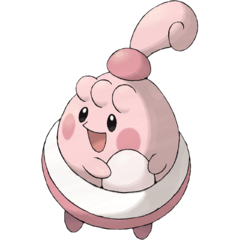

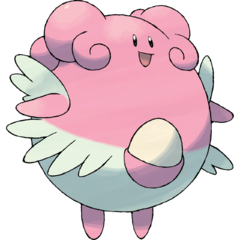
Chansey is a much sought-after Pokémon. Catching them is literally all up to chance, as they're normally only found in the Safari Zone; an area of the game where you don't battle the Pokémon (thus making them very hard to capture) and the Pokémon can run away from you at any time. Once caught, though, they can prove to be one of the best special walls in the game. With access to a number of healing moves and the highest HP stat (and a fantastic special defense) of any Pokémon, they can last for quite a while... unless they have to deal with a Pokémon with strong physical attacks, at which point they're screwed eight ways to Sunday. Unlike Chansey or Blissey, Happiny are too young to lay their own eggs, so instead they carry an egg-shaped rock in their pouch in imitation of their evolved forms.
- Achilles' Heel: Their only weakness, Fighting, is primarily a physical type and they have no Defense to speak of, so a strong Fighting move will crack them like an egg.
- The Artifact: The whole "catching one is up to chance" thing. Even back in Red/Blue, they were also available in Cerulean Cave, making true Safari Zone exclusives like Kangaskhan and Tauros harder to obtain, and since Generation IV, they're relatively easier to obtain in games where they appear. Though they're still hard to actually get due to low encounter and catch rates, at least they don't run away from battle.
- Badass Adorable: Blissey has a cute appearance, and she is able to learn moves from various types of Pokémon.
- Cartoon Creature: The exact thing they're supposed to be based on is unclear. Chansey has elements of the axolotl, given her "hair", tail, pink skin, and rounded, fragile appearance; however, these traits are downplayed or lost in Happiny and Blissey. Bulbapedia suggests they're based on a general concept of females and motherhood, but the best description one can give of these mons is "Pink Egg Thing".
- Combat Medic: In addition to their healing moves (see The Medic below), Blissey has a usable Special Attack stat, and they all get Seismic Toss, so they aren't totally helpless.
- Confusion Fu: Like other Normal-Types, they have a really good movepool, with gems like Fire Blast, Blizzard, and Thunder!
- Counter-Attack: They can be bred to have Counter, which takes the damage from a physical attack and returns it to the sender twofold. Their sky-high HP and abysmal Defense means that they will have a lot of damage to give back, so if they survive the hit, their assailant (if they aren't a Ghost-type) will quickly cease being a problem.
- Crippling Overspecialization: They are designed for one purpose: to be a damage sponge of the ultimate degree against special attacks. Everything else ranges from "average at best" to "the worst in the series," although tricky players can get around this.
- Damage-Sponge Boss: Chansey and Blissey have absolutely absurd HP. Blissey's base HP is 255, which is the highest number a base stat can legitimately be, and Chansey's base HP is just 5 points off from that. At level 100, Blissey's minimum HP is a staggering 620. Maximum HP? 714. This actually patches up their horrible Defense, letting them survive anything that isn't boosted by status buffs or a Fighting-type attack that isn't boosted by STAB. When Dynamaxed, their HP can easily reach four digits.
- Divergent Character Evolution: Gen V introduced Eviolite, an item that boosts the defenses of the Pokémon holding it by 50% as long as they have the ability to evolve. A Chansey holding it is significantly bulkier than the already-bulky Blissey, and becomes the ultimate Stone Wall against Special Attacks. However, holding it means you have to forgo other items and become dependent on Eviolite, so moves like Knock Off, Trick, and Magic Room will cripple her far more than Blissey. Chansey's bad offenses force her to use Seismic Toss if she wants to damage something, while Blissey's Special Attack is high enough that she isn't a complete sitting duck against opponents she can hit super-effectively with the line's movepool.
- Dump Stat: Their Attack and Defense stats, which are among the lowest in the game. Blissey's are both 10 while Happiny's and Chansey's are both 5. Even Shuckle hits harder than Chansey and Happiny.
- Empathic Healer: Prior to Generation VII, their Secret Art Softboiled could be used outside of battle to transfer their HP to injured allies in the party.
- Fantastic Medicinal Bodily Product: Chansey and Blissey have an egg-like object they produce in their pouch. Eating it brings happiness and health to whoever does so. Their signature move Soft-Boiled has the egg used to heal half the user's maximum HP, or give away some of her HP to a party member in the overworld.
- Fight Off the Kryptonite: Despite their extremely low Defense, Chansey and Blissey's HP is so ridiculously high that they can work through it. A Min-Maxed Chansey holding Eviolite can prevent OHKOs from all but STAB Close Combat/High Jump Kick levels of power.
- Fixed Damage Attack: Can learn Seismic Toss to deal damage equal to the user's level, which is very helpful considering the line's non-existent Attack stat and poor-to-mediocre Special Attack stat. Once a move tutor move from Gen III, it was made breedable onto Chansey in Gen VI, and breedable onto Happiny in Gen VIII.
- Friend to All Living Things: Abhor seeing or sensing sadness, and will do whatever they can to make the person or Pokémon who's upset be happy.
- Gameplay and Story Segregation: Chansey is said in many of its Pokédex entries to be very fast when running away. Despite this, their Speed stat is only 50.
- Heal Thyself: Naturally learn Soft-Boiled to restore half of their HP. They can also learn Wish through an event.
- Healing Factor: One of their abilities is Natural Cure, which removes status effects upon switching out.
- Helpful Mook: When a wild Blissey spots you in Hisui, they approach and try to heal you instead of attacking.
- Hoist by Their Own Petard: The move Leech Seed, which drains 1/8 of the target's total HP to the user every turn, can exploit the massive HP stat of Chansey and Blissey to create impressive amounts of residual healing.
- I Am Not Pretty: According to the Pokédex, Happiny doesn't like her curly hair.
- Kryptonite Is Everywhere: A large number of Pokémon favor overpowering physical attacks, and roughly half of them are Fighting-type or use Fighting-type moves. Needless to say, the Egg Pokémon, with their terrible Defense stat, do not appreciate this.
- Magikarp Power: Happiny is... not a good Pokémon, having nothing resembling the bulk of its evolutions and stuck with a sparse movepool; getting one mostly serves as Pokédex completion. On the other hand, Chansey with Eviolite and Blissey are the two bulkiest special walls in the game.
- Mama Bear: In Sun and Moon, if a Pokémon in the "baby" egg group calls for help in a battle, there's a chance a Happiny or a Chansey will show up to protect it. In fact, this is the only way to encounter these Pokémon in the wild in these games.
- Meaningful Name: Chansey/Lucky were named such because you needed a "lucky chance" to catch one (something that became less accurate over time), Blissey/Happinas is a bliss-bringing nurse, and Happiny/Pinpuku is a tiny pink ball of happiness that brings good fortune (fuku).
- The Medic:
- In the anime, Chansey (in Kanto through Sinnoh) and Blissey (in Alola) are used as nursing assistants in Pokémon Centers.
- In-game, they all get a ton of support moves like Heal Pulse, which heals a target for half of its Max HP, and Aromatherapy, which heals all conditions teammates have. One possible ability is "Healer", which has a chance to heal any Pokémon on your side in Double or Triple battles. Special mention goes to an event Chansey that has Wish, which heals whatever Pokémon switches out with her next turn, or herself if she doesn't switch. Since Wish restores HP equal to half the user's max HP, most Pokémon will be fully healed by their Wishes thanks to their extremely high HP stat. Outside of battle, they can use Softboiled to transfer one quarter of their Max HP to another Pokémon.
- Megaton Punch: The Lucky Punch item increases Chansey's chance to land a Critical Hit. Again, their Attack stat is so awful that even the mighty Critical Hit can't bump physical attack damage up much farther than Scratch Damage, and their Special Attack stat is dismal enough (on par with the likes of Pidgey) that special moves won't do much either. It also doesn't work with Blissey, who actually has tolerable Special Attack.
- Metal Slime: In Red and Blue, Chansey are insanely rare in all locations they can be found in and hard to catch due to being prone to flee in Safari Zone. (Later games make her and her evolutionary relatives easier to find.) As a reward, Chansey and Blissey when defeated give out more experience points than any other Pokémon.
- Mighty Glacier: Since Special Attack and Special Defense are one single stat in Red and Blue, Chansey has above-average offensive power in those games.
- Minmaxing: One of the most notoriously minmaxed Pokémon out there. More than half of Chansey's base stats went into its HP, giving it the highest HP in the game until its evolution Blissey came along, and most of the rest into Special Defense, meaning its other stats range from "bad" to "bottom of the barrel". Blissey is a bit less min-maxed as it has usable Special Attack, but its physical stats are still essentially nonexistent.
- Nerf: The Special split that occurred in Generation II greatly reduced Chansey's offensive potential, as it now had to work with a Special Attack stat of 35 (garbage) rather than its previous Special stat of 105 (fairly good). The introduction of Blissey made up for this, however.
- Nice Girl: Incredibly so. They will share their eggs with injured people and Pokémon they come across, and are said to bring happiness to others.
- In Legends Arceus, if one spots you while you are injured, she will run right up to you and heal you. While usually being spotted by a Pokemon halts your Regenerating Health, you can heal to full if it's just a Chansey or a Blissey. All bets are off if it's an Alpha, though.
- Non-Elemental: All three are Normal-types.
- One-Gender Race: Always female.
- Our Fairies Are Different: While not actually Fairy-type, Chansey and Blissey can learn Dazzling Gleam via TM and belong in the Fairy Egg Group.
- Perpetual Smiler: All three of them.
- Piñata Enemy: While not as famous as its fellow pink medic Audino in this department, the Chansey family gives out an absurd amount of Experience Points once defeated in battle. They're even associated with an item known as the Lucky Egg, which doubles experience points when held. It also helps that most attacks they get by level-up (or, prior to Generation VIII, all of them) are physical moves backed by the worst Attack stats in the series, making them almost completely incapable of doing damage when encountered in the wild.
- Pink Means Feminine: This line is female-only, and all three forms are pink.
- Pokémon Speak: The Chansey from Copycat's house in Saffron City says "Chann! Sii" in her NPC dialogue.
- Power Up Letdown: The line's Hidden Ability is Healer. Not only does the line already get Heal Bell and Aromatherapy to reliably cure adjacent allies from harmful status conditions, the ability does nothing whatsoever for Chansey/Blissey themselves, which means it's useless in Single Battles.
- Resistant to Magic: Majorly so, having high Special Defense backed by the highest HP stat in existence.
- Ridiculously Cute Critter: The whole family are considered to be quite cute.
- Scratch Damage: The Confusion status and Foul Play attack do next to nothing to the line; it uses the target's own Attack stat for the move, while all three have no real Attack stat to speak of (Blissey's Attack stat is 10, the prior evolutions have 5).
- Secret Art: Softboiled, outside of Generation III and Mew in Generation I.
- Squishy Wizard: In the Gen 1 games, the Special stat was used for both offense and defense, so Chansey could actually hit things back.
- Stone Wall: Indisputably the best special wall in the game, laughing at any special attackers that aren't swimming in Status Buffs. While they don't like physical hits very much, a maximum Defense investment makes them surprisingly capable of taking them.
- Taking You with Me: Since recoil moves subtract the user's HP based on how much the victim loses to the attack, putting a full-HP Chansey or Blissey in the way of it is a nice way to horribly damage or even knock out anything that uses a powerful recoil move.
- Useless Useful Spell: All of the damaging moves they learn via level-up are physical attacks. Which work off the lowest Attack stats in the game. No amount of Min-Maxing or status buffs can salvage it; they're that weak.
- White Magician Girl: Not only does it have bright colours, a solely female species, and a pleasant personality to fit this trope, it also learns a significant amount of supportive and healing skills. While this doesn't usually do it much good in a Single Battle (as the only thing it can target with things like Heal Pulse are the enemy Pokémon), in a double battle or a Raid, it becomes a very effective cleric who can keep the team alive while they whittle down the enemy.
0114: Tangela / Monjara (モンジャラ monjara)
0465: Tangrowth / Mojumbo (モジャンボ mojanbo)
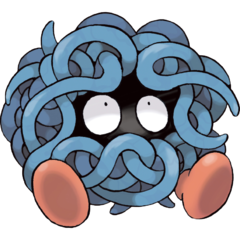
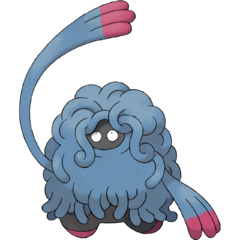
Tangela is a figure obscured by blue vines. It was a pretty dull Pokémon back in Gen I; the only notable attribute was that it was a pure Grass-type (all the others were dual-types, mostly Grass/Poison), but that wasn't anything to write home about. When Tangrowth was introduced in Gen IV, its usefulness jumped tenfold since it's a great physical wall, and capable of utilizing both physical and special moves well.
- Achilles' Heel: Tangrowth is a bulky, hard-hitting juggernaut that can shrug off basically any physical attack you can think of. On the other hand, it has poor Special Defense, meaning that a single super-effective special attack can easily send Tangrowth packing.
- Armless Biped: Tangela doesn't get arms until it evolves into Tangrowth.
- Boss Battle: A rampaging Tangrowth is the first boss of Pokémon Ranger: Shadows Of Almia.
- Combat Tentacles: Their vines act as these. The line can learn Constrict, Bind, and Wring Out, among other sorts of moves, to illustrate this.
- Contemporary Caveman: Tangrowth's wild, shaggy appearance and prehistoric motif calls to mind popular depictions of cavemen, particularly one specific fictional caveman.
- Dishing Out Dirt: Tangela evolves into Tangrowth by learning the Rock-type attack Ancient Power. In addition, evolving gives it more attacks that involve this, such as Earthquake and Rock Slide.
- Gentle Giant: Despite being unintelligent and 6'7'' tall, Tangrowth is noted to be very friendly.
- Good Thing You Can Heal: One Pokédex entry says that Tangrowth sometimes get their arms ripped off by predators. It doesn't seem to care or notice, as they grow back very quickly.
- Green Thumb: Notably, Tangela is the only one of the original 151 to be a pure Grass-type.
- Healing Factor:
- Tangrowth is said to immediately regrow its arms if it loses them.
- Both Tangela and Tangrowth have Regenerator as their Hidden Ability, healing some of their health whenever they switch out.
- It naturally learns Ingrain, which can be further added to with Leech Seed (which it can be bred with), and all three Grass Life Drain moves that, as of Pokémon Black 2 and White 2, it can learn naturally.
- Lightning Bruiser: They can turn into this thanks to their Chlorophyll ability, which doubles their speed stat in sunshine.
- Magic Knight: Tangrowth's offensive stats are high and relatively close (100 Attack and 110 Special Attack), allowing it to hit hard from either spectrum or run a mixed offensive set.
- Mighty Glacier: Tangrowth has a decent Attack and good Special Attack stat along with great Defense and HP, but it happens to have poor Special Defense and Speed (though its slow speed can be migitated if it has the Chlorophyll ability).
- Non-Damaging Status Infliction Attack: Learns the Poison Powder/Stun Spore/Sleep Powder trio naturally.
- Prehistoric Monster: By Retcon in Generation IV; Tangela will evolve into Tangrowth by leveling up after learning Ancient Power, which is associated primarily with Fossil Pokémon and Legendaries.
- Secret Character: In Pokémon Diamond and Pearl, Tangrowth can only be obtained by transferring Tangela from Gen III and leveling it up while knowing Ancient Power. Pokémon Platinum onwards downplays its status by making Tangela available in-game.
- Stand Your Ground: They can learn Ingrain, which prevents them from getting switched out for better or worse.
- Stone Wall: Especially in Gen I, where it had very high Defense and Special. Later generations expanded its movepool, but its Generation I Special stat became its Special Attack, making it weak to special attackers.
- Vine Tentacles: Naturally learns Vine Whip and Power Whip.
- Waddling Head: Tangela's design consists of just its head almost totally covered in vines besides its eyes, with red feet sticking out.
- Weak to Magic: Tangela has a surprisingly high 100 Special Attack stat, but a Special Defense stat of 40. Evolving only brings the Special Defense stat up to 50, so special-based attacks make short work of it.
- You Have Researched Breathing: Tangela, despite being covered in vines and aptly called the "Vine Pokémon", could not learn Vine Whip until Yellow.
- You Will Not Evade Me: They naturally learn Block, which prevents the target from switching out or fleeing.
0115: Kangaskhan / Garura (ガルーラ garuura)
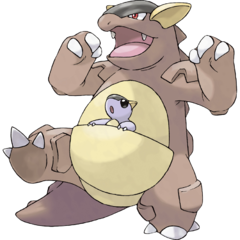
Kangaskhan gained a Mega Evolution in X and Y; however, unlike most Mega Evolutions, Kangaskhan herself is unchanged. Instead, her baby ages up into a child and climbs out of its mother's pouch to fight alongside her, represented by the two of them gaining the unique Parental Bond ability that adds an extra weaker hit to all of their attacking moves.
- Action Initiative: They can learn Sucker Punch and Fake Out.
- Action Mom: They fight while having a baby in their pouch.
- Actually Four Mooks: The mother doesn't change in appearance when Mega Evolving, but the baby "grows" bigger and a bit more mature and can attack as well, making the pair attack twice in the same turn.
- The Artifact: Its status as a One-Gender Race and a one-stage line seems odd considering mechanics added in later games:
- Kangaskhan are always Born as an Adult with a baby in their pouch, even with pre-evolutions being introduced alongside breeding.
- Male Kangaskhan had to be retconned out of the franchise due to the initial lack of gender differences when genders were introduced, as well as Pokémon with alternate forms in the first generation. Since then, there have been Pokémon whose males and females look significantly different, but it's never been used to reintroduce male Kangaskhan.
- Badass Adorable: The Mega Evolution has the baby join the mother to fight.
- Badass and Baby: Under normal circumstances, the baby is still in the pouch while the mother fights...unless it Mega Evolves.
- Badass and Child Duo: Mega Kangaskhan invokes this with the child working in tandem with its mother.
- Badass Family: A single Pokémon manages to count as one.
- Bizarre Alien Reproduction: Unlike other Generation I Pokémon that recieved a baby form in Generation II, Kangashkan never recieved one. As a result, not only does the Pokémon never actually appear by itself as the baby it carries around, it also hatches from eggs already carrying said baby.
- Blood Knight: Mega Evolving forces the baby to grow but fills it with so much aggression that all it can think of is fighting, causing its mother to worry about its future.
- Boring, but Practical: In early games, they made for a decent HM user if you managed to capture one.
- Born as an Adult: They can be hatched from eggs with another baby to take care of!
- Boxing Kangaroo: They are vaguely based on kangaroos and can learn a variety of punching moves, notably Mega Punch, Comet Punch, and Dizzy Punch.
- Combat Pragmatist: Mega Kanghaskhan has no problem attacking twice, which makes it extremely lethal. Presumably, the grown child is the one who delivers the second hit. It can also learn a few Dark-type moves like Crunch and Sucker Punch.
- Confusion Fu: As is par for a Gen I Normal-type, Kangaskhan's movepool is extremely wide, and they can run so many potential sets that Mega Kangaskhan is frightening to battle.
- Disc-One Nuke: In HeartGold and SoulSilver, Kangaskhan was a common Pokémon in early Pokéwalker routes, came with Dizzy Punch, and has stats high enough to last you throughout the game.
- The Dividual: In the games, both mother and child count as a single Pokémon, and the baby has never been seen on its own. Even breeding a Kangaskhan results in a parent and child hatching from the same egg.
- Jack of All Stats: A fairly well-rounded Pokémon that is surprisingly efficient, but does nothing amazing either. When it Mega Evolves, however...
- Kaiju: Kangaskhan is based on a kangaroo, but its appearance bears more resemblance to vaguely dinosaur-inspired monsters such as Nidoking, Nidoqueen, and Rhydon. Unsurprisingly, all of them are in the Monster egg group and can breed with each other.
- Kangaroo Pouch Ride: An early episode of the anime depicted Kangaskhan as large enough to allow not only its baby but also a young human boy and eventually the rest of his human family to fit comfortably inside its pouch. Later episodes would scale Kangaskhan back to its regular size, and this has never been attempted since.
- Kangaroos Represent Australia: In Pokémon GO, Kangaskhan can only be caught naturally in Australia.
- Lightning Bruiser: Mega Kangaskhan gets all of its stats buffed while the Parental Bond ability makes it hit extra hard.
- Little Miss Badass: The baby comes out to fight when it Mega Evolves. It's the reason why Parental Bond gives them a second attack on each damaging move.
- Loophole Abuse: Parental Bond ordinarily has the second attack have a fraction of the first attack's power. However, when using a Fixed Damage Attack like Seismic Toss, the second attack's power is not reduced, which lets Mega Kangaskahn do a huge chunk of damage regardless of defenses.
- Magically Inept Fighter: Kangaskhan has an okay 95 base Attack that increases to base 125 upon Mega Evolving, but its Special Attack is poor.
- Mama Bear: You mess with the baby, you die. This is even reflected in Pokémon Amie/Refresh, where they will react with hostility if you even touch the baby. The Sun and Moon Pokédex entries mention that they become distraught when the child grows up and leaves them, and they become uneasy about the baby's future during Mega Evolution as the child only appears to be good at fighting.
- Metal Slime: They tend to have a very low encounter rate in practically every game they appear in, so getting your hands on a Kangaskahn will require a lot of patience.
- Mini-Me: The baby Kangaskhan looks even more like the adult version during the Pokémon's Mega Evolution.
 ◊
◊ - Named After Somebody Famous: Its name is a pun on Genghis Khan.
- Names to Run Away from Really Fast: Having one based off of Genghis Khan is pretty much a given.
- Nerf: Starting in Pokémon Sun and Moon, the second hit from Mega Kangaskhan's Parental Bond ability had its power reduced from 50 percent to 25 percent of the first hit's power.
- Non-Elemental: They're Normal-type Pokémon.
- Older Alter Ego: When Mega Evolving, Kangaskhan's baby spontaneously ages up into a child so it can fight alongside its mother. When the Mega Evolution wears off, the child reverts to a baby.
- One-Gender Race: Always female. In-universe, how they're able to have the baby riding in the pouch without a male isn't mentioned, although according to the Pokédex book from 1996, male Kangaskhan is supposed to be a thing.
- Parental Substitute: In Sun and Moon, it can show up when Cubone calls for help.
- Portmanteau: Their Japanese name combines kangaroo with ruler, making Garūra (though Garooler would be a more accurate transliteration). The English name combines Kangaroo and Genghis Khan.
- The Power of Love: As with all Mega Evolutions, this is the in-universe fuel for the process. In regards to them, however, it's the mother's love and selflessness that allow the baby to turn it up a notch, hence their ability.
- Secret Art:
- Dizzy Punch, until Crystal. It's a damaging punch attack that has a chance to cause confusion.
- The Parental Bond ability is exclusive to Mega Kangaskhan. It causes them to attack twice for each damaging attack, with the second hit dealing 50% (in Gen VI) / 25% (in Gen VII) of the damage the first hit did.
- Super Mode: Gets access to Mega Evolution in Pokémon X and Y onward. While Mega Evolved, all of its stats are increased and it gains the Parental Bond ability, giving an automatic second attack each turn that does 50% (in Gen VI) or 25% (in Gen VII) of the damage dealt by the first. Unlike most Mega Evolutions, the baby is the one that undergoes the physical change and presumably, the second attack comes from the child.
- Together in Death: If Mega Kangaskhan faints, the mother and child will hug each other as they return to the Poké Ball.
- Took a Level in Badass: Whenever the pair get their hands on some Kangaskhanite, it's time for the baby to achieve something much more than sitting in the pouch all day.
0116: Horsea / Tattu (タッツー tattsuu)
0117: Seadra (シードラ shiidora)
0230: Kingdra (キングドラ kingudora)
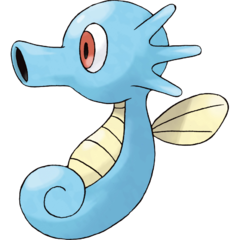
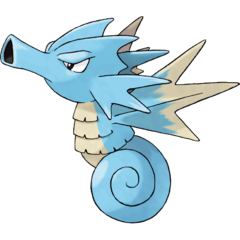

Based on seahorses, Horsea and Seadra were typical Water-types, although that isn't saying much, since there are a lot of Water-types to choose from. Then Gen II came around and it gained an evolution in the form of Kingdra, and a new typing which leaves it with a big number of resistances. Dragon and Fairy are the only types that can be super-effective (minus Freeze Dry), and exploiting the first is risky since Kingdra is likely to pack Dragon-type moves itself.
- Blow You Away: Kingdra can be taught Hurricane with a TR in Sword and Shield, which works extremely well with Swift Swim.
- Boss Battle: Kingdra is this twice. The first time is as Clair's signature in the Johto games. The second time is with Juan in Emerald.
- A Kingdra controlled by Team Dim Sun is the boss of the Sea of Wailord in Pokémon Ranger: Shadows Of Almia.
- Critical Hit Class: With the change to the critical hit formula in Generation VI, a Kingdra holding a Scope Lens will always land critical hits after using Focus Energy. As critical hits ignore decreases to the user's attacking stats, this allows Kingdra to spam Draco Meteor with no drawback. This is accentuated by its Sniper ability, which further increases the power of critical hits.
- Glass Cannon: Seadra doesn't have the benefit of increased Special Defense, Health, or the Dragon-typing.
- In a Single Bound: Strangely, they can be tutored Bounce.
- Irony: Real life seahorses are among the slowest animals in the animal kingdom, period, with many species being slower than your average garden snail. Not only do Horsea, Seadra and Kingdra posess average to good speed for their evolutionary stages, but as mentioned below, they have 3 ways to raise that speed stat to become even faster.
- Jack of All Stats: Kingdra's stats are fairly comparable to the perfectly balanced Silvally's, falling just 20 points short in HP and 10 in Speed.
- Making a Splash: All three are Water-types.
- Non-Indicative Name: There are no Queendra, only female Kingdra.
- Our Dragons Are Different: Kingdra, who is a seahorse like the rest of its family. And said rest of the family is identified as the Dragon Pokémon in the Pokédex. Makes sense, because Kingdra is based off the Weedy Sea Dragon.

- Papa Wolf: Much like real seahorses, Seadra raise the young, and its Sword Dex entry notes that a Seadra raising Horsea will produce thicker and stronger poison from their back spines.
- Perpetual Frowner: With its slanted eyes, Seadra looks like it's in a bad mood all the time. Kingdra only gets angrier and more menacing, despite its softer features.
- Poisonous Person: Not Poison-type, but Seadra can have the Poison Point ability, which has a chance of inflicting poison when hit with "contact" moves. Multiple Pokédex entries reference the fact that they have venomous spines on their back fins. They can also learn Clear Smog via breeding (with a Shellos), and can even inherit moves from fellow seahorse dragons Skrelp and Dragalge (themselves Poison-type).
- Power Up Letdown: The line gets Damp as a Hidden Ability. Not only do Sniper and Swift Swim enable entirely different playstyles for Kingdra, Generation V (which also introduced Hidden Abilities) also nerfed Explosion and Self-Destruct, making them incredibly uncommon in competitive gameplay. It can be used as of Gen VIII to avoid Misty Explosion though, which would otherwise deal extremely high damage to Kingdra.
- Ridiculously Cute Critter: Horsea is a cute little seahorse.
- The Rival: Kingdra's Isle of Armor Sword Pokédex entry mentions that it and Dragonite will fight on sight upon meeting in the wild.
- Seahorses Are Dragons: As expected of eastern media, the idea of seahorses having draconic qualities are particularly strong in Pokémon, and all three stages are denoted as the Dragon Pokémon, though only Kingdra is actually a Dragon-type.
- Seahorse Steed: Can be this if taught Surf, which allows a Pokémon to be ridden over water on the overworld.
- Secret Art: They can inherit Octazooka from Octillery.
- Smoke Out: When in danger Horsea spit out ink to mask their escape.
- Socialization Bonus: Seadra needs to be traded while holding a Dragon Scale in order to evolve. However, Kingdra are rare wild encounters in some games.
- Status Buff: The Swift Swim ability doubles their Speed during rain. They can also learn the moves Dragon Dance (raise Attack and Speed by 1 stage each) and Agility (raises Speed by 2 stages).
- When All You Have Is a Hammer…:
- Kingdra doesn't have much in the way of type coverage. It doesn't need it, because Water and Dragon deal at least neutral damage to all but 15 Pokémon.
- Furthermore, like most Water-types, it has access to Ice-type moves, which are super-effective against most of the types that resist Water. Only 6 Pokémon can outright resist all three of those types.
0118: Goldeen / Tosakinto (トサキント tosakinto)
0119: Seaking / Azumao (アズマオウ azumaou)


Goldeen and Seaking are beautiful goldfish Pokémon that have horns on their heads. Despite their docile appearance, they're actually quite aggressive. They use their horns for attacking and even to absorb Electric moves (if they have the Lightning Rod ability). While based on goldfish, their habit of traveling up waterfalls and laying their eggs in quiet streams also bring salmon to mind. They were also the first Pokémon to have an HM move, Waterfall coincidentally, as part of their level up moveset.
- Adaptational Wimp: In the anime and Super Smash Bros., Goldeen is a useless fish that flops about helplessly, a role that's usually fulfilled by Magikarp.
- Balance Buff: The physical/special split allowed the line to take advantage of their Attack stat, especially with their Signature Move Waterfall being reclassified as Physical. Beforehand, Water-type moves ran off their weaker Special Attack.
- Confusion Fu: Can learn moves from 9 out of 18 different typesnote , including Throat Chop as a tutor move in Pokémon Ultra Sun and Ultra Moon. Presumably, if it wasn't for the line's mediocre stats, it would be considered a serious threat, especially if this versatility was combined with Lightning Rod, as seen below.
- Elemental Absorption: With Lightning Rod, not only is it immune to Electric moves, it gains a boost to its Special Attack, which actually brings it up to the level of its physical Attack.
- Glass Cannon: Their best stat is their physical Attack, while the others are average at best.
- Healing Factor: Naturally learns Aqua Ring, which gradually restores a bit of health each turn.
- Horn Attack: Learns several attacks evidently based around use of its horn, such as Fury Attack, Megahorn, Poison Jab (though that needs to be relearned), and, of course, the Trope Namer itself.
- Killer Rabbit: Goldeen have a wild temperament despite their elegant looks and are known to break out of aquariums with their horns and ram humans that swim too close.
- Making a Splash: They're Water-types based on goldfish.
- Non-Indicative Name: There are plenty of female Seaking.
- Secret Art: Waterfall, in the first Generation. Goldeen and Seaking were the only two Pokémon that can learn it by leveling up before the Let's Go Games allowed the Seel and Horsea lines, as well as Gyarados to learn it as well, putting them among the very, very few Pokémon that can learn HMs by such method, alongside Salamence and Rayquaza (Fly), and the 5 families that can learn Dive, and the few Pokémon that could learn Whirlpool when it was still an HM (although the first Pokémon who could learn it were in Generation III where it was no longer an HM, it regained its HM status during HeartGold and SoulSilver, before losing it again in Gen V).
- Status Buff: The Swift Swim ability doubles their Speed during rain.
- Status-Buff Dispel: Can be bred with Haze, which removes all stat changes (positive and negative) for everything on the field when used.
- This Is a Drill: Learns Horn Drill naturally, Drill Run from Move Tutors.
- Useless Useful Spell: A user of the Soak move, which turns the target into a Water-type. Like most Pokémon that get the move, it can't really abuse it much.
0120: Staryu / Hitodeman (ヒトデマン hitodeman)
0121: Starmie (スターミー sutaamii)
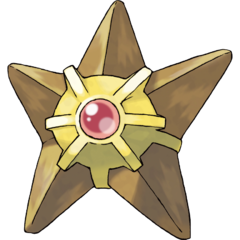
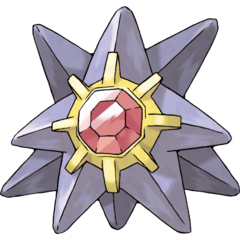
Staryu and Starmie are very unusual Pokémon. Unlike real starfish, which move by creeping along the bottom, Staryu and Starmie are best known for whipping around at high speeds like shuriken. They also have amazing healing powers, but don't have much in the way of a face, which is just a glowing red gem and the source of their power. Starmie is part Psychic-type as well and learns a variety of attacks that most Water-types can't learn, such as Thunderbolt, Power Gem, and Dazzling Gleam.
- Awesome, but Impractical: Starmie is way too fast to be able to make good use of Analytic, its Hidden Ability (which boosts the power of moves if the user goes last). That is, unless you attack your opponent after they switch in, since that does count as "moving first" for the purposes of the ability. Another option, though highly impractical, would be using Trick Room to reverse the attacking order so that Starmie will (most likely) always move last and activate Analytic, in which case the problem becomes ensuring that Starmie actually lives long enough to attack.
- Bizarre Alien Biology: Staryu used to have Camouflage as a Secret Art back in Generation III, a move which allowed it to change its own type, and a Pokémon’s type is generally implied to be tied to its biology, implying that the Pokémon who use it can change the very nature of their own body.
- The Blank: The closest thing it has to a face is the gem in the center.
- Boss Battle: Starmie is Gym Leader Misty's signature Pokémon.
- Confusion Fu: They have a fairly good specially offensive learnset, with Water, Bug, Rock, Ice, Electric, Psychic, Fairy, Steel, and Grass-type moves.
- Early Installment Character-Design Difference: Earlier 3D Pokémon games portray Staryu and Starmie as being flexible due to their limbs moving and Starmie's back half rotating on its own. Since the standarzied models appeared in Generation VI, they have been portrayed as stiff and unmoving, with minimal limb movement, and Starmie's rear half not moving.
- Eye Lights Out: In the anime, their cores slowly stop glowing when they faint.
- Foil:
- To the Shellder line. Both are Pokémon that can be fished up, evolve via a Water Stone and may be found holding Shop Fodder, sometimes they are version exclusive (Shellder is exclusive to FireRed and Y while Staryu is exclusive to LeafGreen and X). While Cloyster is a Mighty Glacier, Starmie is a Fragile Speedster.
- To the Mareanie line. Both are based on the crown-of-thorns starfish (Mareanie moreso than Staryu), but the Mareanie line is highly aggressive while the Staryu line is pretty docile. Ironically, their stats favor the opposite playstyle to their temperament — Toxapex is a Stone Wall with a Healing Factor, while Starmie is a Fragile Speedster with a Healing Factor. Starmie's Psychic type also gives it a potent advantage over the Poison-type Toxapex.
- Fragile Speedster: Starmie is one of the fastest Water-types and among the fastest Pokémon. While Starmie's defenses are actually average, its HP is pretty low.
- Gemstone Assault: With those shining cores, they're capable of using Power Gem.
- Glass Cannon: Starmie has real good Speed (base 115) and Special Attack (base 100), but while its Defenses are average (both its Physical and Special are at a base 85), its HP is quite poor (base 60).
- Green Thumb: Can learn Grass Knot.
- Healing Factor: They can regenerate any part of their body as long as the core is intact, learn the move Recover, and can have the Natural Cure ability to remove status effects by switching out.
- Hermaphrodite: The printed Japanese Pokedex book states that Staryu and Starmie are "gynadrous" or hermaphrodites, in that they have both male and female reproductive organs. This may explain why in later gens when genders and breeding are available, they are classified as "genderless" or "gender unknown" for the sake of simplicity.
- An Ice Person: Starmie is well-known for using Ice Beam.
- In-Series Nickname: According to Starmie's Ruby Pokédex entry, it's called the "gem of the sea."
- Making a Splash: They're Water-types based off of starfish/sea stars.
- Missing Secret: Staryu has a couple Egg Moves listed for it in Gold and Silver, though they are impossible to obtain because genderless Pokémon can't breed without a Ditto (who can't pass down Egg Moves).
- No Biological Sex: One of the only examples of a fully biological Pokémon that isn't a Legendary, Mythical, or Ultra Beast to be this.
- Not Completely Useless: Analytic will grant the user the damage boost if the opponent switches out for their action, as switching is almost always done before moves are executed. While almost worthless against the AI since they very rarely switch, it may be useful against human opponents, as it forces them to either stay in and get hit hard by Starmie, or try to switch and risk getting hit even harder by Starmie.
- Piñata Enemy: Starting in Generation II, they have a chance of holding Stardust and Star Pieces.
- Pokémon Speak: In Sun and Moon. Normally this wouldn't be notable, but Staryu and Starmie stand out as an example because they didn't originally do this.
- Power Copying: Staryu is one of the few Pokémon able to learn the move Reflect Type, which causes the user to copy the typing of their opponent.
- Power Crystal: The gem in the center is implied to be the source of their power, or at the very least their brain.
- Psychic Powers: Starmie is a Psychic-type. Several Pokédex entries mention that it sends radio signals into the sky/space.
- Punny Name: Staryu, Starmie ("You" and "Me")
- Purple Is Powerful: Starmie is very purple, very powerful, and very fast.
- Secret Art: When the move Camouflage debuted in Generation III, it was exclusive to the Staryu line. When used, it causes them to change their type based off of the environment the battle is taking place in.
- Shock and Awe: Starmie is well-known for using Thunderbolt, but can also learn Thunder.
- Shout-Out: To Ultraman. Let's count them — Staryu's Japanese name is Hitodeman. It has a crystal core which apparently tells its status, like Ultra beings. It has a fondness of the night sky, referencing how Ultra beings came from space. It learns a lot of beam moves, referencing the iconic but multiple variations of Ultraman Beam attacks. Its anime cry of having a human-sounding grunt and shout is similar to how the Ultra characters almost never speak outwards, instead only grunting and shouting. And this Pokémon Music short
 solidifies it (fighting other kaijuu-inspired Pokémon Nidoking and Tyranitar even).
solidifies it (fighting other kaijuu-inspired Pokémon Nidoking and Tyranitar even). - Shown Their Work: In real life, starfish/sea stars can actually regenerate body parts as long as the central disc is intact. This matches its Healing Factor abilities quite well.
- Spectacular Spinning: Starmie has another star attached to its back that is constantly spinning, which it uses to propel itself along. They also learn moves such as Rapid Spin and Gyro Ball. In the anime, they spin like a shuriken, and they do the same in Stadium when using certain moves like Thunderbolt.
- Starfish Aliens: Literally. Starmie's Pokédex entry in the first Stadium game says it may hail from space.
- Useless Useful Spell: One of Stayru's level-up moves is Gyro Ball, a Physical Steel-type attack that does more damage if the user is slower than the target. Both Staryu and Starmie have a low Attack stat and good Speed, making it completely worthless.
439: Mime Jr. / Manene (マネネ manene)
122: Mr. Mime / Barrierd (バリヤード bariyaado)
866: Mr. Rime / Barrikohru (バリコオル; barikooru)

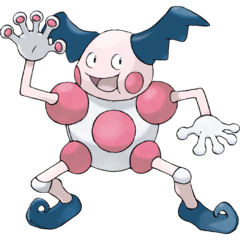
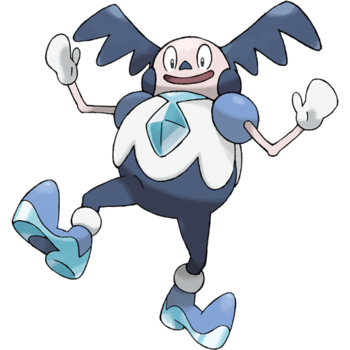
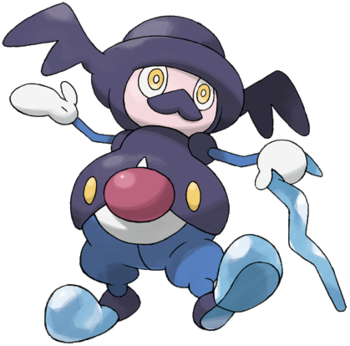
Mr. Mime is a Psychic-type clown Pokémon with a talent for mimicking and miming. It is especially talented at creating transparent walls, which is very useful for repelling attacks. The English name Mr. Mime may imply that it's supposed to be male, but they can be either male or female. In the Gen I games, there was an NPC who was willing to trade their Mr. Mime for an Abra, and it was the only way to get it. In later generations, it became more common, and it even received a baby with the name Mime Jr., going with the theme of having a title in their name. Just like its evolved form, it's good at mimicking people and Pokémon. Both it and its pre-evolution became part Fairy in Gen VI.
Mr. Mime in the Galar region are Ice/Psychic type and can evolve into Mr. Rime. Instead of miming, Galarian Mr. Mime and Mr. Rime specialize in vaudevillian tap-dancing.
- An Ice Person: Galarian Mr. Mime and Mr. Rime are part Ice-type.
- Armored But Frail: Kantonian Mr. Mime is the specially-oriented version of this trope, having great Special Defense, but very poor HP. Galarian Mr. Mime tones it down with its more evenly-distributed stats.
- Art Evolution: Kantonian Mr. Mime's model and animations have been tweaked in Pokémon Legends: Arceus to be cuter and more expressive than in previous 3D games, coming across as a bit less of a Creepy Doll-esque figure and having a more endearing grin on its face as its default expression.
- The Artifact: The English localization turned Barrierd, a gender-neutral name, into Mr. Mime, implying a One-Gender Race, back when there wasn't gender data. Nob Osagawara, the translator of the games up to Platinum and a member of Something Awful under the name Doug Dinsdale, revealed that he said naming it Mr. Mime would come to bite them in the ass if gender is ever introduced, which of course it did.
- The English name is even more of an artifact for Galarian Mr. Mime, which downplays its mime aspects in favor of tap-dancing. Even the Japanese name is something of an artifact, as the move Barrier is
 Dummied Out in Pokémon Sword and Shield and the Galarian Mr. Mime line's Screen Cleaner ability will remove barriers from both sides of the field.
Dummied Out in Pokémon Sword and Shield and the Galarian Mr. Mime line's Screen Cleaner ability will remove barriers from both sides of the field.
- The English name is even more of an artifact for Galarian Mr. Mime, which downplays its mime aspects in favor of tap-dancing. Even the Japanese name is something of an artifact, as the move Barrier is
- Barrier Warrior: Mr. Mime is heavily associated with this, and learns Reflect, Light Screen, Barrier, Quick Guard, Wide Guard, and Safeguard naturally.
- Galarian Mr. Mime and Mr. Rime can work as an inversion of this with their ability Screen Cleaner, which removes the effects of Reflect, Light Screen, and Aurora Veil from both the player and the opponent upon entering the battle.
- Belly Mouth: Mr. Rime's expression never changes, but the clownish face-like design on its torso inexplicably takes over making expressions to match its actions.
- Breakout Character: Perhaps due to its role in Pokémon Detective Pikachu being well-received, the following generation (VIII) gave Mr. Mime a lot of attention; it received a new regional variant, an evolution for said regional variant, and also became a more prominent character in the anime.
- Breaking Old Trends: The Mime Jr. family is the first instance of branched evolutions having different numbers of evolutionary stages across each branch.
- Charlie Chaplin Shout-Out: Mr. Rime is based on Charlie Chaplin (specifically, his Charlot/Little Tramp character), who wore a bowler hat, a battered, baggy tuxedo, had a short mustache, and shoes that were bigger than his feet, making him look clownish. Mr. Rime also carries a walking cane made of ice, and it walks in a clumsy tap-dancing motion (which is also reflected by one of its Abilities, Tangled Feet). Mr. Rime is native to the Galar region, which is based on Charlie Chaplin's home country, the UK.
- Clown Species: Extremely humanoid in appearance, but make no mistake, Mr. Mime and Mime Jr. are Pokémon with a natural talent for miming and have innate psychic abilities.
- Confusion Fu: Galarian Mr. Mime and Mr. Rime learn a surprising amount of moves, both offensively and defensively. Mr. Rime's relatively even stats means it can take advantage of a lot of these moves, making them deceptively unpredictable.
- Cool Old Guy: Mr. Rime resembles an elderly man, with its Shield 'dex entry mentioning that it's very popular due to its charming movements.
- Crouching Moron, Hidden Badass: It may be slightly silly and have subpar stats as Mr. Mime, but it has a wide movepool and can wreak havoc on an unsuspecting foe with high Special Attack and Speed. Becoming part Fairy-type has helped it a lot.
- Creepy Doll: X and Y gives Mr. Mime jerky animations and a more defined dummy-like jaw, making it seem like a disturbing puppet or doll. Pokémon Detective Pikachu at least makes it less toy-like and more believable as a living creature, but it has a weird, inorganic-looking basketball-like texture on its shoulders for some reason.
- Crutch Character: If you haven't raised a Kadabra, you'll be relying on Mr. Mime for a lot of the Pokémon Tower to deal with the Ghost-types in it (and that only works because said Ghosts are also Poison-types — try this against the Ghosts in any other generation, and you'll soon regret it). After that, Mr. Mime tends not to be that useful and many players will opt to replace it.
- Dance Battler: Galarian Mr. Mime and Mr. Rime specialize in tap-dancing while battling. Mime Jr. in the Galar Region will look for a Mr. Rime to be apprenticed to.
- Deliberately Monochrome: The shiny forms for Galarian Mr. Mime and Mr. Rime are grayscale, another reference to its connection to silent film comedians known for physical comedy (i.e. Charlie Chaplin).
- Demonic Dummy: Mr. Mime's face reflects the jaw typically seen on these.
- Depending on the Writer: Different Pokédex entries offer varying explanations for its power to create solid objects, either that it actively manipulates atoms into holding still or that it convinces the audience that such things are real and that's how they come to exist.
- Discard and Draw:
- Mime Jr. that evolve in Galar trade their Fairy-typing for Ice.
- Mr. Rime has considerably less speed than its pre-evolution, but gains more well-rounded stats everywhere else in return.
- Ditto Fighter: To a certain extent, as Mime Jr. can learn Mimic (the requisite for its evolution into Mr. Mime), as expected from the Mime Pokémon.
- Early Installment Character-Design Difference: Likely due to its cartoonish nature, Mr. Mime used to be always depicted with Four-Fingered Hands in the main games. However, most spin-off titles and adaptations gave it five fingers, instead. Starting with FireRed and LeafGreen, Mr. Mime was given five fingers.
- Enemy Mime: These mimes can set up Reflect and Light Screen.
- Evil Laugh: Mr. Mime's cry in the Stadium games sounds hauntingly like a human laughing maniacally.
- Eyes Do Not Belong There: Mr. Rime has an extra pair of yellow eyes on its torso.
- The Fair Folk: In addition to being rather unnatural-looking, one of Mr. Mime's Pokédex entries implies this.It is adept at conning people. It is said to be able to create walls out of thin air by miming.
- Foil: While it was largely independent in the early franchise years, it has since accumulated a few pointed contrasts with other Pokémon.
- Generation II introduced Sudowoodo, another pokémon who used mimicry as The Gimmick; in terms of stats Mr. Mime was specially oriented and quick, while Sudowoodo was physically-oriented and slow. Neither of them had much to do with one another until Gen IV gave them both brand-new pre-evolutions that both needed to learn Mimic to evolve; the Artist trainer class of the Sinnoh games specialized in fielding both lines to highlight the similarity.
- By Generation VI, it's very clear that it's this to the Jynx line. Both of them resemble humans in colorful clothing. They're both now dual-typed Psychic-type Pokémon with favorable typings against Dragons, with a baby form, similar base stat total (Mr. Mime is only 5 points higher than Jynx), and who could only be acquired in Gen I by an in-game trade. Generation VIII makes the family fill the same niche as Jynx instead by making their Galarian forms Ice/Psychic.
- Hu Mons: Mr. Mime is based on a mime and looks like a person in clown get-up, complete with goofy hair and pointed shoes. The Galarian version and its evolution Mr. Rime are instead inspired by tap dancers and wear tap shoes made of ice. Mr. Rime takes it a step further by also being based on Charlie Chaplin's 'Tramp' character; it has a bowler hat, mustache, and a cane!
- An Ice Person: Galarian Mr. Mime and Mr. Rime are part Ice-type, the former generating ice using its feet and the latter using a tap cane made from an icicle.
- Jack of All Stats: Invoked with Galarian Mr. Mime and Mr. Rime. The Galarian version of Mr. Mime sacrifices some of its Special Attack and Special Defense to patch up its extremely low Attack and HP (as well as a bit more speed), while Mr. Rime's stats across the board are relatively even. They both also learn a lot of useful offensive and defensive moves, giving them a surprising amount of flexibility.
- Living Toys: Mime Jr. looks like a hand puppet with legs. Mr. Mime is a much more unnerving doll/dummy.
- Marionette Motion: Mr. Mime's default animation is to lean back and forth jerkily while placing its hands on an invisible wall in front of it.
- Monster Clown: Mr. Mime is quite literally this if facing against it, as it resembles a clown and it's a Pocket Monster (Pokémon). Mr. Rime applies even more so, having an extra face on its torso for extra creepiness.
- Morphic Resonance: The eyes and nose of Mr. Rime's Belly Mouth are taken from Mime Jr.
- Non-Indicative Name: They look more like clowns, but are named for their mime-like behavior. There are also female Mr. Mime and Rime out there. Galarian Mr. Mime also do not mime, but specialize in tap dancing instead.
- Non-Ironic Clown: Mime Jr. was designed with cuteness in mind, and so averts the creepiness of its evolutions.
- Our Fairies Are Different: As of Generation VI, they are part Fairy-type, representing living objects and the Uncanny Valley.
- Perpetual Smiler: Mime Jr. always wears a smile. Mr. Mime has a less cheery one.
- Power Up Letdown: Downplayed. Screen Cleaner removes the effects of screen moves such as Reflect and Light Screen from both sides of the field when Mr. Rime enters or returns to battle. That means Mr. Rime has to set up its own Reflect and Light Screen each time it comes back.
- Punny Name: Mr. Rime are named after the term "rime", which refers to a kind of frost, befitting their Ice typing. It may also invoke "rhyme", as they are regional variants and counterparts to the standard Mr. Mime family.
- Psychic Powers: All of them are Psychic-types. They use these powers to make invisible walls.
- Secret Art:
- Mr. Mime was the only Pokémon that could learn Substitute by level-up, at least until Generation III.
- Galarian Mr. Mime and Mr. Rime are the only Pokémon with the ability Screen Cleaner, which nullifies the effects of Light Screen, Reflect, and Aurora Veil for both the player and the opponent.
- Squishy Wizard: It hits hard and fast, but it can't hold its own when the time comes, and even at higher levels, its HP is considerably lower than that of some other Psychic-types. More zigzagged with Galarian Mr. Mime and Mr. Rime, with their more balanced stats giving them better bulk, but their Ice-typing also gives them more weaknesses.
- Underground Monkey: Galarian Mr. Mime prefer living in chilly environments. So they've become Ice/Psychic types. They evolve from Mime Jr. in Galar itself but are also capable of evolving into Mr. Rime.
- Youkai:
- They appear to be based on tsukumogami, or objects that come to life after 100 years. In this case, they're clown toys.
- Mr. Rime in particular seems to be based on the haradashi, a yokai with a large face on its belly. The haradashi would visit people who feel sad or lonely, and would try to cheer them up, sometimes by dancing.
- Your Mime Makes It Real: Pretending that you're behind an invisible wall is a standard miming routine. Mr. Mime is capable of making real invisible walls to defend itself against attacks.
0123: Scyther / Strike (ストライク sutoraiku)
0212: Scizor / Hassam (ハッサム hassamu)
0900: Kleavor / Basagiri (バサギリ; basagiri)

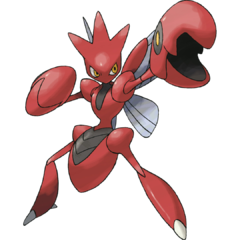
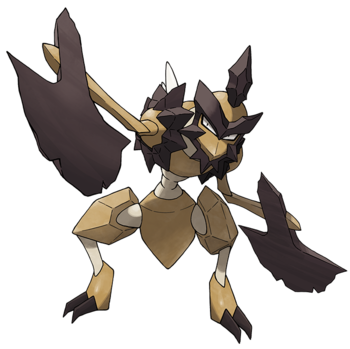
Kleavor debuts in Legends: Arceus
Savage mantis bug-types. Scyther is a green person-sized Pokémon with a raptor-like head and scythes for arms. It's a pretty cool Pokémon, but it suffers a bit for being a Bug/Flying-type. It later gained an evolved form in Scizor. It loses its dinosaur-like characteristics and its blinding speed and becomes a Bug/Steel-type, but it more than makes up for it in terms of attack, defenses, resistances, and moves. It was exclusive to the Red version in its debut generation. Scizor is one of several Pokémon to receive a Mega Evolution in X and Y. Mega Scizor's claws become serrated and it also gains more armor.
Scyther who used to live in the ancient Hisui region were known for using a volcanic stone called Black Augurite to evolve into Kleavor, a Bug/Rock-type with massive rock axes for arms that chip and sharpen with repeated use, with battle-hardened Kleavor being recognized by the large chipping across their bodies. In modern times Kleavor do still exist, but are very rare due to Black Augurite being very difficult to find.
- Absurdly Sharp Blade: Scyther's blade arms can cut apart logs and massive trees in a single stroke, and its Ultra Sun Dex entry mentions that they're dexterous enough with their blades to dress their prey before eating.
- Achilles' Heel: As a Scyther, Rock type moves will destroy it immediately. Scizor does not like Fire-Type moves, which is also its only weakness.
- Action Initiative: Both evolutions can naturally learn a variety of priority moves, including Quick Attack, Vacuum Wave, Feint, and (for Scizor only) Bullet Punch, all of which are further boosted by their ability Technician to hit harder.
- The Artifact: Scyther is the only Pokémon with the same base stat total as its evolutions, just redistributed. This may be a side effect of Scizor being introduced before the concept of statistically different forms was introduced, which frequently redistribute the base stat total in the same manner. As a remnant of this to possibly prevent one from being explicitly better than the other, Kleavor does the same thing and simply redistributes its stats. This puts it in a category alongside Eevee, where a Pokemon with branching evolutions can legitimately be kept unevolved for a complete different playstyle.
- Big Creepy-Crawlies: Person-sized ninja mantis-dinosaurs.
- Blade Below the Shoulder: Moreso Scyther and Kleavor with their arm blades, though Scizor can count as well with its scissorhand pincers.
- Body Horror: A Mega Evolved Scizor's body will start melting if it stays on its Mega Evolved form for too long, due to the excess energy.
- Boring, but Practical:
- Scizor has a fairly limited movepool and an even more limited variety of sets that it uses, but it hits like a train, has an excellent defensive dual-typing that, aside from Fire, makes every type hit it for neutral damage at best, and has access to a fantastic Ability that boosts any attacks that have 60 or less Power by 50%. Coupled with the fact that every generation has introduced more items, moves, and gameplay elements that are nothing but kind to it, Scizor is a Pokémon that will always be predictable, but undeniably good at destroying things and making game-changing plays.
- Scyther can hold the Eviolite, an item specifically designed to boost the defensive stats of not-fully evolved Pokémon; this covers its otherwise most glaring flaw.
- Boss Battle:
- Scyther is the second gym boss of Gen II, being Bugsy's Signature Mon.
- Kleavor serves as a Noble Pokémon in Legends: Arceus. Which are kind of like Totem Pokémon in the Gen 7 games.
- Breakout Character: Scizor is very popular among fans who grew up with the Generation II games, which led to it receiving a Mega Evolutionnote and a character slot in the aimed-at-older-fans Pokkén Tournament. It's also received minor nods like merchandise and Assist Character representation in Super Smash Bros..
- Brutish Character, Brutish Weapon: Kleavor is described as crude and violent, and has stone axes for hands.
- Cartoon Creature:
- Scyther already has a tenuous connection to its mantis inspiration, but Scizor's design takes so much artistic license that it more resembles a wasp or winged ant (or even a wasp-mimicking mantidfly). No one can say for sure what specific insect it's based off, and its names in most languages don't offer any such clue.
- Kleavor takes the samurai-motif up a notch and even gives has a top-knot made of rock while only looking vaguely like a mantis.
- Chainsaw Good: Mega Scizor's claws sort of resemble chainsaws.
- Crafted from Animals: People in Hisui use the stone that chips off Kleavor's body for crafting tools.
- Discard and Draw: Scyther is the only Pokémon whose base stat total doesn't change when it evolves. Both Scizor and Kleavor simply reallocate some of the existing values for their stat spreads, causing what was once a speedy Glass Cannon to become one of two Mighty Glaciers.
- Upon evolving into Scizor, Scyther loses its Flying type in exchange for the Steel type. This gets rid of Scyther's many weaknesses but now makes it neutral to Fighting and Ground-types and even more vulnerable to Fire-types. It also loses Speed in return for boosts in Attack and Defense; the amount of Speed it loses is equal to the total gain in its Attack and Defense.
- Upon evolving into Kleavor, Scyther loses the Flying-type in exchange for the Rock type, gaining fewer weaknesses but resisting fewer types in return. It also loses Speed and Special Defense for boosts in Attack and Defense, but its Speed doesn't decrease as signficantly as Scizor's.
- Dishing Out Dirt: Scyther in the Hisui region are capable of evolving into a Bug/Rock Pokémon known as Kleavor, which is partially made of stone and is based around flint knapping.
- Divergent Character Evolution:
- With Pinsir. They started as direct counterparts as version-exclusive large Bug Pokémon that didn't suck, but then Scyther got an evolution, and Pinsir became part of a Japanese Beetle Brothers duo with Heracross. Because of this choice, they had to diverge even further in Gen VI. Mega Heracross and Mega Scizor still match up, but Mega Pinsir stands alone because since Scyther is technically unevolved (despite sharing the same stat total with Scizor), it can't use Mega Stones.
- Within the same species, Scyther is a Glass Cannon/Fragile Speedster, while Scizor is a Mighty Glacier, and the former is quite a usable Pokémon even though it's unevolved (in fact, the stat total doesn't change upon evolution), so 2 identical Scythers will end up playing quite differently if one is evolved and the other is not. Due to being able to evolve, Scyther can take advantage of the Eviolite.
- Explosive Overclocking: While the energy surge from Mega Evolution makes Mega Scizor much more powerful than its regular form, it's unable to properly vent excess heat; as such, its body will start melting if it maintains the form for too long.
- Extra-ore-dinary:
- Scizor. Notably, it was one of the few Pokémon that happily carried a Steel-type attack around before Gen VI improved Steel's viability as an offensive type.
- Scizor's Shield Dex entry mentions that even its muscles are at least partially made of metal.
- Flight: Scyther (although it can't learn Fly) is part Flying-type, though it only rarely uses its wings to fly. Scizor's ability to do so is inconsistent.
- Foreshadowing: Scyther can learn the move Steel Wing, which, in addition to being a useful counter to Rock and Fairy-type Pokemon, is also an allusion to its evolution into Scizor, which is a metal Bug.
- Glass Cannon: Scyther has good attack and speed, but only moderate defenses and a typing with many weaknesses.
- Heal Thyself: Like most Flying-types and their evolutions, both can learn Roost. Scizor is notable in that it is not a Flying-type unlike Scyther, and thus ignores Roost's normal side effect of not being Flying-type for the turn it's used.
- Hair-Trigger Temper: Scyther and Kleavor are noted to be highly aggressive and are to be avoided in the wild if possible.
- Jack of All Stats: Scyther has the third-highest base stats of all unevolved Pokémon, beat only by Type: Null and Porygon2, and with Eviolite, Scyther's modest 80 points in both defense and special defense are jacked up to be deceptively bulky in conjunction with Roost without losing its naturally good attack and speed. Eviolite Scyther is still more frail than other Pokémon with similar stats due to having many exploitable type weaknesses, but can serve as an excellent Support Party Member role with moves such as Tailwind and Quick Guard combined with offensive utility moves such as Knock Off and Bug Bite.
- Magically Inept Fighter: Great Attack, abysmal Special Attack. Nevertheless, the entire line learns Hyper Beam.
- Mighty Glacier:
- Scizor has a high Attack stat, good Defense, decent Special Defense, and it's only weak to Fire-type attacks. However, it's slow and said weakness is easy to exploit since it takes x4 damage from it.
- Mega Scizor is bulkier than Skarmorynote while still being stronger than normal Scizor. Its Speed does receive a minor boost, but it's still fairly slow.
- Compared to Scizor, Kleavor has a worse defensive typing and slightly worse defenses (as well as Special Attack), but slightly higher Attack and significantly better (though still not amazing) Speed.
- Ninja: Scyther has a ninja-esque motif.
- Ninja Pirate Zombie Robot: They're human-sized ninja-styled preying mantises. And Scizor is made of metal, while Scyther has draconic elements in its design (like many other Gen 1 Pokémon).
- Non-Indicative Name: Scizor's hands resemble pincers more than scissors.
- Not Completely Useless: Light Metal does see some use as a strategy to lessen the power of Low Kick specifically for Mega-Scizor variants, since Scizor "regains" the more useful Technician when it Mega Evolves, but even then it's a niche case.
- Poor, Predictable Rock: Their natural movepool is rather shallow, with few moves that benefit from Technician that provide good coverage apart from the Flying, Bug, and Steel-type moves that one or both get STAB on. note As a result, they are heavily reliant on U-turn, Bug Bite, Aerial Ace, and (for Scizor) Bullet Punch as their primary moves, though they can offset this gap with Swords Dance. Their limited options got a useful expansion in the DLC for Sword and Shield, which introduced Dual Wingbeat, a 40 base power attack that hits twice. Thanks to Technician, Scyther and Scizor are unarguably the current best users of this move, for Scyther in particular it becomes a 180 base power move if both hits connect, making it the only Flying type attack you're likely to ever see one use in a serious battle. Furthermore, it's highly unlikely that you'll see anything other than a Technician variant, as the 90 effective BP that a 60-BP move has with the ability is stronger than all but three moves that they can learn, all of which are non-STAB and come with heavy drawbacks.
- Power Pincers: Scizor's pincers are said to have the strength to crush any hard object into bits. According to its Sword Pokédex entry, they make up a third of Scizor's weight.
- Power-Up Letdown:
- Scizor's Hidden Ability, Light Metal. It halves Scizor's weight (and unlike the move Autotomize which also halves the weight, Light Metal doesn't grant a speed boost by two stages), but the common moves that deal damage based on weight (E.G Grass Knot and Low Kick) are moves that Scizor isn't bothered by in the first place, and it makes Scizor even more vulnerable to Heat Crash.
- To a lesser extent, Scyther's Hidden Ability, Steadfast. This raises Scyther's Speed whenever it flinches, but given that Scyther's a Fragile Speedster (and flinching requires moving after the opponent), Scyther won't be flinching a lot.
- The Ability Swarm is this as well. While boosting the power of Bug-type attacks may seem worthwhile, it requires Scyther to be near fainting itself, and the moves buffed are moves Scyther already gains STAB from; it's better to use Technician, which grants a similar buff to all moves below a certain threshold.
- Raptor Attack: Scyther looks and acts less like a praying mantis and more like a Jurassic Park-brand Velociraptor, being aggressive, swift, worryingly clever, and capable of attacking in a flash with razor-sharp claws. The main difference is that Scyther is depicted as a solitary (and incredibly territorial) hunter as opposed to traveling in packs.
- Samurai: Scizor fittingly has some samurai-ish traits, such as its warrior disposition and arm blades. Kleavor takes it up to 11 with its top-knot.
- Secret Art:
- Metal Claw for Scizor, until Pokémon Crystal, when Sneasel could learn it too. Afterward, it became more widespread.
- Stone Axe for Kleavor, a Rock-type move with a high critical hit ratio that also does more Damage Over Time (in Legends: Arceus) or sets up Stealth Rock (in the more traditional games).
- Shear Menace: Although it uses Power Pincers, Scizor was known as the Scissors Pokémon in Gen II and early on in the anime, and learns a few slashing moves by leveling up.
- Signature Move:
- Ever since it gained the combination of Bullet Punch and Technician in Gen IV, Scizor is highly associated with the move in peripheral media.
- Swords Dance also counts for both Scyther and Scizor, but to a lesser extent.
- While it's not ever been a move exclusive to the line, it's hard not to think of the Physically-damaging Bug-type move X-Scissor as not having been made with Scyther in mind, due to it being one of the only Bug with something even approaching scissors on its body.
- Kleavor learns the unique move Stone Axe, which is legitimately exclusive to it.
- Sinister Scythe: Instead of hands, Scyther has scythe-shaped claws. The entire family learns the move X-Scissor, a powerful Bug-type move which plays into the line's impressive attack stat.
- Slaying Mantis: With raptor-like features and a metal or rock shell respectively for extra badassery.
- Socialization Bonus: Scyther needs to be traded with a Metal Coat in order to evolve into Scizor. Since link trades aren't a thing in Legends: Arceus it instead evolves when being "exposed" to a Link Cable, a held item which falls from Space/Time Rifts.
- Super Mode: Gained a Mega Evolution in X and Y.
- Takes One to Kill One: As a Bug/Rock-type, Kleavor is weak against Rock-type attacks.
- Turns Red: Not made use of often, being overshadowed by Technician and all, but both can make use of the Swarm Ability to boost their Bug-type attacks while they're at low health.
- Weak to Fire:
- As Bug-types, both Scyther and Scizor don't take well to fire, but Scizor is especially vulnerable since Fire deals quadruple damage and is the only type that is super effective against it.
- On top of this, Scizor has to use its wings to cool itself down due to being in danger of always Overheating and melting in the middle of battle. It's even worse with Mega Scizor, who can't properly dissipate the energy from Mega Evolution afterwards and will eventually break down from it.
- When All You Have Is a Hammer…: Scizor's movepool may be limited, but it gives it exactly what it needs to wreak havoc on the opponent and deal massive damage to a variety of Pokémon. It can also be improved with the use of TMs.
- Wings Do Nothing: According to the Pokédex in some games, Scizor's wings are not used for flying, but to regulate its body temperature. If not for this, Scizor's body would overheat and melt.
- Xtreme Kool Letterz: Scizor (Scissor) and Kleavor (Cleaver).
- You Will Not Evade Me: Can learn Pursuit, which deals extra damage when the opponent attempts to switch. It also gets boosted by Technician if the opponent doesn't switch.
0238: Smoochum / Muchul (ムチュール muchuuru)
0124: Jynx / Rougela (ルージュラ ruujura)

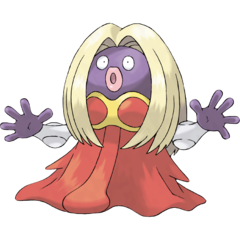
Lots of things can be said about Jynx. It's an Ice/Psychic Pokémon with poor attack and defense, but wonderful special stats and speed. It's got a lot in common with other human-shaped Pokémon. It's been compared to Mr. Mime (both were only available in in-game trades and both are Psychic-types that look similar and have similar stat totals) and Magmar and Electabuzz (they form a Fire, Ice, and Lightning trio, and they all received babies in Gen II). Their kisses can confuse or put its target to sleep.
- Astonishingly Appropriate Appearance: Jynx is an Ice-type with purple skin, and purple discoloration of the skin is a common symptom of frostbite.
- Blackface-Style Caricature: Jynx's original design bore an unfortunate resemblance to a racist blackface caricature, and became the subject of controversy as a result. The design was changed to have purple skin starting with Pokémon Gold and Silver*, and was retroactively altered for Virtual Console releases of older games, notably creating a Non-Standard Character Design situation in Pokémon Yellow.
- Brawn Hilda: This may be one aspect of Jynx's design, due to its breastplate and emphasis on singing.
- Captain Ersatz: Datamining and early documents finally revealed that Jynx is a version of the daikaiju "Woo" from the Ultra Series put in a dress. The Woo are a race of all female yeti creatures that care for children lost on snowy mountains. The beta design for Jynx was called "Boo" and looked identical to the Woo.
- Combat Clairvoyance: Gets the Forewarn Ability, which points out the most powerful move the opponent has when Jynx is switched in.
- Depending on the Writer: It's not really agreed upon if Jynx has legs underneath its dress. Many of the 3D models and Pokédex pages where they show footprints suggest that they don't, while the anime and Pokédex body shape entries suggest that they do.
- Distaff Counterpart: To Mr. Mime (despite its sexual ratio), and to Magmar and Electabuzz (despite them also being able to be females).
- Divergent Character Evolution: Originally part of a Fire, Ice, Lightning trio with Magmar and Electabuzz, but because it didn't get an evolved form at the same time as they did, it has since become more of a feminine counterpart to Mr. Mime.
- Elemental Punch: Can learn Ice Punch. Notably, in Gen I, it was the only Pokémon aside from Hitmonchan to learn the move.
- Fire, Ice, Lightning: With Magmar and Electabuzz, as the only natural learners of the Elemental Punch besides Hitmonchan in Gen I. They received baby forms with the same evolution requirements in Gen II. However, this line has always been closer to Mr. Mime's in terms of stats, and it didn't get a third stage in Gen IV like Magmar and Electabuzz did.
- Foil: By Generation VI, it's very clear that it's this to the Mr. Mime line. Both of them resemble humans in colorful clothing. They're both now dual-typed Psychic-type Pokémon with favorable typings against Dragons, a baby form, similar base stat totals (Mr. Mime is only 5 points higher than Jynx), and who could only be acquired in Gen I by an in-game trade.
- Glass Cannon: Jynx is a great special attacker with some strong special defense to boot, but one hit from physical attacks can take her down instantly.
- Gyaru Girl: The original intention for Jynx was that it is a Yama-uba combined with this fashion style.
- Healing Factor: Smoochum can heal off status effects in the rain if it has Hydration as an ability; Jynx replaces this with Dry Skin, which gradually restores its HP in the rain instead.
- Hu Mons: Jynx is a humanoid female Pokémon with a design that's likely partially inspired by ganguro fashion; it sports the blonde hair, high-contrast makeup, and dark skin associated with the style.
- An Ice Person: They're Ice-types based on the Yama-uba, a mountain hag youkai that controls ice.
- Lady in Red: Subverted. Jynx isn't wearing a red dress— like most Pokémon that seem to wear clothes, her "dress" is actually part of her body. For further proof, many 3D models show that the underside of the "dress" is shadowy and there are no legs underneath. In almost every game-accurate artistic representation of Jynx, the dress is also unmistakably fleshy in its texture. The anime has depicted them with feet.
- Missing Secret: In Gold and Silver, Smoochum has the move Lovely Kiss listed as a possible Egg Move, but it's impossible to learn legitimately, since the only Pokémon to learn it is its evolution, and female Pokémon couldn't pass down moves until Generation VI. The move was removed from the list in Crystal and was never added back, in spite of the situation being now possible.
- Non-Standard Character Design: Its Pokémon Yellow sprite for the Virtual Console uniquely has five colors (black, white, red, yellow, and the newly added purple) instead of four in order to reflect her redesign in the 2000's. Despite what is often believed, this is actually possible in a Game Boy Color gameExplanation.
- One-Gender Race: Always female.
- Our Sirens Are Different: Jynx seems to be partially inspired by the Sirens, with her strong association with singing and music and her apparent characterization as a sort of "temptress".
- Pink Is Erotic: Befitting a Pokémon described in-universe as flirty and seductive, Jynx has bright pink lips and wears a bright pink dress in both her international Pokémon Gold and Silver sprite and her shiny coloration in later games (which otherwise restore her earlier red dress).
- Post-Kiss Catatonia: Jynx weaponizes this trope— Lovely Kiss puts whoever is hit with it into a deep sleep.
- Psychic Powers: Both are Psychic-type feminine humanoids.
- Purple Is the New Black: The end result of the controversy was a design change where Jynx's color was changed from black to purple.
- Red Baron: In Galar, Jynx were once feared and worshipped as the Queen of Ice.
- Retcon: Jynx's skin was changed from black to purple due to complaints that she resembled Blackface. This has extended not only to newly-released games, but to re-releases of older games such as Pokémon Snap and Pokémon Yellow Version.
- Secret Art: Lovely Kiss is exclusive to Jynx.
- Squishy Wizard: Impressive Special Attack that can be boosted further with Nasty Plot. While their Special Defense is actually pretty good, their HP is lacking, and their terrible Defense ensures that they'll fold to a beating in no time. note The Ice-typing also isn't really great defensively either, but it's useful offensively.
- The Unintelligible: Jynx's cries sound human, but nobody can figure out what they mean. In the Mystery Dungeon games, Jynx's quotes are all gibberish.
- Youkai: Jynx is based on a combination of the Yama-Uba, a mountain crone/witch that has power over ice and is portrayed in Noh plays with actors in blackface and wigs (explaining its unusual typing of Psychic/Ice), and Yamanba, a subculture named for its resemblance to said crone, which involves heavy tanning and bleached hair.
- You Will Not Evade Me: Naturally learns Mean Look, which prevents the foe from fleeing. This pairs very well with Perish Song, also learned naturally by it.
0239: Elekid (エレキッド erekiddo)
0125: Electabuzz / Eleboo (エレブー erebuu)
0466: Electivire / Elekible (エレキブル erekiburu)


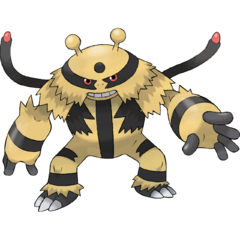
The Electabuzz family are yellow and black-striped Pokémon that have great control over electricity. If they have a basis, though, they appear to be based on Oni of Japanese legend. Their best moves involve pummeling their opponents with electrified fists. They seem to be direct counterparts to the Magmar family. They were only found in the Red version in their debut generation.
- Acrofatic: Electivire can move pretty fast despite its bulky frame and weighing over 300 pounds. It's slightly downplayed in that Electabuzz (which is far less bulky-looking) is slightly faster — however, if Electivire's Motor Drive kicks in...
- Badass Adorable: Elekid has much higher stats than most of the other "baby" pre-evolutions introduced in Gen II, boasting rather impressive Speed. It surpasses even Pikachu's stats, let alone Pichu.
- Berserk Button: Electabuzz cannot stand the color red, according to the anime.
- Boss Battle:
- Electivire in Platinum, being Volkner's signature.
- Electabuzz is this in the Johto games, replacing Raichu as Lt.Surge's strongest Pokémon.
- In Pokémon Ranger: Shadows of Almia, Electivire is used by Heath during your second battle against him.
- Breakout Character: Of its Fire, Ice, Lightning trio, the Electabuzz line gets the most spotlight. Electivire is a brutal and intimidating Pokémon with amazing strength, movepool, and Ability. In addition, two of the anime's strongest and most memorable rivals — Paul and Gary — have trained Electivire, and those Electivire are some of the strongest Pokémon in their teams.
- Cartoon Creature: There are features from quite a few different creatures in Electabuzz's design — monkeys, cats, humans, Sasquatch...
- Elemental Absorption: Using an Electric move on a Motor Drive Electivire just gives it a Speed boost.
- Elemental Punch: In Gen I, Electabuzz was the only Pokémon, aside from Hitmonchan, to learn Thunderpunch. Unlike the other two Pokémon it's frequently associated with, Electabuzz can learn all three elemental punches.
- Fire, Ice, Lightning: In Gen II, Jynx was included as a trio with it and Magmar, evolving from its baby form at Level 30 like them, in moveset Jynx was actually more similar to Magmar than Electabuzz was, and each of them are closely associated with one of the three Elemental Punches. Subsequent generations have focused on Jynx as a Foil to the Mr. Mime line, however, while Electabuzz and Magmar became even closer.
- Foil: To the Magmar line. The stat totals of their members are very similarnote , just distributed differently, their movesets are mirror images learning moves with similar effects at the same levels, they evolve in the same manner as each other, and are sometimes version exclusive.
- Fragile Speedster: Electabuzz is rather fast as expected from an Electric-type Pokémon, but it can't take hits.
- Glass Cannon: Electivire has a fantastic Attack stats, but its bulk just barely improves upon evolving. Although Electivire is still decently fast, it's actually slower than Electabuzz.
- An Ice Person: In a way. Until Gen IV, this line was the only one among Electric-types that could learn an Ice-type move outside of Hidden Power to counter most types resistant to Electric moves. But to this day. it remains the only Electric-type line able to learn Ice Punch, which is a much better alternative to the Shinx line's Ice Fang.
- Lightning/Fire Juxtaposition: Has this with the Magmar line.
- Oni: Electabuzz seems to be based on these, with its horns and tiger-stripe pattern (referencing how oni often wear tiger pelts).
- Psycho Electro: Natures aside, this family is said to have less-than-friendly dispositions and happen to be Electric-types.
- The Rival: Elekid's Moon Dex entry mentions that they fight with Togedemaru that try to steal their electricity.
- The Scapegoat: Electabuzz's Ultra Moon Dex entry mentions that due to their reputation for stealing electricity from power plants, they're blamed for power outages even when the cause is due to human error on the part of the electric companies. Given that this wasn't carried over to Sword and Shield, it raises the question of how truthful this is.
- Secret Art: Electivire's Motor Drive ability, until Gen V. Motor Drive raises its speed if hit by an Electric-type move.
- Shock and Awe: All three of them are pure Electric-type oni Pokémon.
- Socialization Bonus: Electabuzz needs to be traded while holding an Electirizer in order to evolve.
- Spectacular Spinning: Elekid spin their arms around to charge up electricity. Electabuzz spins up its arms to increase the power of its punches; unfortunately, this gives the target enough time to run away.
- Tail Slap: Electivire is said to use its twin tails in combat.
0240: Magby / Buby (ブビィ bubii)
0126: Magmar / Boober (ブーバー buubaa)
0467: Magmortar / Booburn (ブーバーン buubaan)
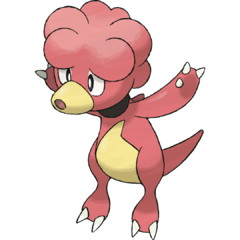

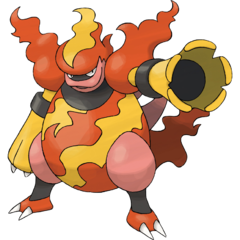
Despite being in the humanshape egg group, Magmar and its kin don't seem to look human-like at all, seemingly having more in common with duck-billed dinosaurs. They're nominally based on a bird (the booby) but are more like anthromorphic personifications of fire itself. They've usually appeared alongside the Electabuzz family. They were only found in the Blue version in their debut generation.
- Arm Cannon: Magmortar has two and retracts its claws before using them in some materials.
- Badass Adorable: Despite not excelling in any particular area, like Elekid, Magby has much higher stats than any of the other "baby" pre-evolutions of its respective era.
- Bird People: Magby and Magmar vaguely resemble birds due to their beaks. Magmortar, however, completely drops this.
- Boss Battle: Magmortar, as Elite Four Flint's signature in Platinum.
- A Magmortar and four Magmar serve as the first boss fight of Fire Island Volcano in Pokémon Super Mystery Dungeon.
- In Pokémon Ranger: Shadows of Almia, Magmortar is used by Lavana during your second battle against her.
- Cartoon Creature: The line is apparently based on a blue-footed booby, but they all don't look like the birds. Their appearance is more in line with other cartoony creatures like Nidoking and Slowbro.
- Elemental Punch: Naturally learns Fire Punch and Thunderpunch (though the latter is only on Magmortar and needs to be relearned). Notably, Magmar was the only Pokémon outside of Hitmonchan to learn Fire Punch in Gen I.
- Feathered Fiend: If you can believe it's supposed to be a bird, and it does appear to have some kind of fluffy covering like feathers.
- Fire, Ice, Lightning: With Electabuzz and Jynx, as described in their entries; they were the original users of the elemental punches, after all.
- Foil: To Electabuzz, as described above.
- Fragile Speedster: Magmar has a good Speed stat of 93, but its Defense isn't very good.
- Gag Lips: Magmortar has these in place of the beak its previous stages have.
- Glass Cannon: Magmar has all around decent Attack, Special Attack, and Special Defense, but poor Defense. Magmortar has even higher Special Attack and better defenses, but its physical Defense is still low.
- Incendiary Exponent: Magmar and Magmortar's bodies are on fire.
- Lightning/Fire Juxtaposition: With the Electric-type Electabuzz line.
- Magma Man: In addition to fire moves (including Lava Plume), it also learns Earthquake. The line is also well known for being able to live in magma without issue and has blood like magma coursing through their veins.
- Mighty Glacier: Magmortar is slower but has higher Special Attack and defenses. Defense still isn't that great, though, and like Electivire it is slower at 83 Speed, though this is still above average, even among fully evolved Pokémon.
- Mundane Utility:
- Magby's Moon Dex entry mentions that one uses its flames to help a famous potter create fine works.
- Magmortar's Ultra Sun Dex entry mentions that many factories still rely on their flames in order to process metals.
- Playing with Fire: All three are Fire-types that live in and near volcanoes.
- Sean Connery Is About to Shoot You: Magmortar in its Platinum sprite has its cannon already aimed at your Pokémon as the battle begins, and its official artwork has it aiming to the right of the camera.
- Shock and Awe: Magmortar is the only non-Legendary Fire-type able to learn Thunderbolt.
- Socialization Bonus: Magmar needs to be traded while holding a Magmarizer in order to evolve.
- Status Buff: A rare user of Belly Drum, letting it make better use of its decent physical Attack and physical movepool. It can also be bred with Barrier, allowing it to potentially patch up its poor Defense.
- Status-Buff Dispel: Pokémon Black 2 and White 2 gave it Clear Smog, which lets it clear all Status Buffs off of any opponent it hits.
- Wreathed in Flames: Its Flame Body Ability gives it a chance to inflict a burn onto any opponent that physically strikes it.
0127: Pinsir / Kailios (カイロス kairosu)

A stag beetle with two oversized horns, which act much like pincers. It likes to crush things with them, and anything it can't crush, it tosses far away. It's the version counterpart to Scyther, and can be found in the Blue version in its debut generation. In later generations, it became the version counterpart to Heracross. In X and Y, Pinsir gained a Mega Evolution. Its Mega Evolution gains the ability to fly and an Ability that turns Normal-type attacks into supercharged Flying-type attacks. Now nowhere is safe.
- Always Accurate Attack: One of the few Pokémon to learn Vital Throw, and naturally learns it to boot. Vital Throw makes the user attack last, but never misses.
- Bare-Fisted Monk: Although it isn't a Fighting-type, most of its damaging learnset consists of Fighting-type moves. This provides an interesting contrast to its foil Heracross, which also learns Fighting-type moves and actually is a Fighting-type.
- Big Creepy-Crawlies: Pinsir is a really huge stag beetle.
- Blow You Away: Mega Pinsir is part Flying-type and has the Aerilate agility, which turns normal-type moves into Flying-type moves.
- Cast from Hit Points: One of the few Pokémon to learn Submission, which is considered one of the worst moves that does recoil damage. Mega Pinsir (once transferred through Pokébank) can use Double-Edge, which becomes a base 156 Power Flying attack before STAB through Aerilate. Naturally, this can wear it out quickly.
- Critical Hit: Pinsir is one of only three Pokémon that can learn Storm Throw, which always results in a critical hit.
- Divergent Character Evolution:
- It used to be the version counterpart to Scyther, as both of them were Bug-type Pokémon that were actually good, until Scyther got an evolution. After that, it became part of a Japanese Beetle Brothers duo with Heracross.
- It diverges from Heracross in their Mega Evolutions. While Mega Heracross is more of a Mighty Glacier, Mega Pinsir is a Lightning Bruiser, ironically playing quite similarly to Scyther.
- Enemy Mine: While they are normally rivals with Heracross in other regions, in Alola, both of them are friendlier due to their shared rivalry with Vikavolt.
- The Grappler: Pinsir is a Bug-type whose movepool consists of many Fighting-type moves, including moves like Circle Throw, Storm Throw, Vital Throw, Submission, and Seismic Toss. A regular Pinsir is also mentioned to be able to easily lift opponents who are twice its weight using the horns on its head, while Mega Pinsir can lift ones who are ten times its own weight.
- Hot-Blooded: Its Mega Evolution's Dex entry in Sun states that it's in a state of constant excitement. This is actually one of the tamest effects Mega Evolution has on a Pokémon.
- Japanese Beetle Brothers: A Kuwagatamushi, Heracross being the Kabutomushi.
- Kill Streak: Its Hidden Ability is Moxie, which boosts its Attack for every opponent it knocks out.
- Lightning Bruiser: Upon Mega Evolving, Mega Pinsir gains 20 points to its Speed and defenses, and 30 points to its Attack. Its ability happens to be Aerilate, which turns Normal-type moves into Flying-type while also slightly boosting its power.
- Mighty Glacier: Regular Pinsir has an amazing Attack and Defense stat, but its speed isn't high enough to be considered fast.
- Mundane Utility: One of the best unorthodox uses of its Mega Evolution, which gives it the devastating ability to convert Normal-type attacks into more powerful and STAB-boosted Flying-type attacks, is to give it the Normal-type False Swipe, making it a fantastic choice for softening up wild Pokémon for capture. It's also one of only three Pokémon that can use False Swipe on a Ghost without using Foresight or Odor Sleuth on them beforehand (the other two being Scrappy Pancham and Pangoro).
- One-Hit KO: One of the original users of the move Guillotine, which has low accuracy but instantly knocks the target out if it connects. Given the original name of the move translating into "Pincer Guillotine," it's not hard to see how it works.
- Power Gives You Wings: It gains wings when it Mega Evolves, becoming part Flying-type in the process.
- Power Pincers: On its head. What did you think it was named for? It can grip a foe weighing twice its own weight. Accordingly, it learns a lot of moves that involve crushing foes in their pincers.
- The Rival: In most regions where both are found, its main rival is Heracross, a fellow beetle Pokémon. However, in Alola, its main rival is Vikavolt, to the point where Pinsir and Heracross are actually friendly with one another in opposition to Vikavolt.
- Super Mode: Gained a Mega Evolution in X and Y. It gained a new type, along with an ability that changes all Normal moves to Flying. It might have finally caught that break.
- Tough Beetles: Pinsir is based on a stag beetle and has solid Attack and Defense stats. Its most distinguishing feature is the pair of thick, impressive pincers on the top of its head, which it uses to split its prey in half.
- Wrestler in All of Us: Not a Fighting-type, but learns more Fighting moves than Bug ones. note
0128: Tauros / Kentauros (ケンタロス kentarosu)
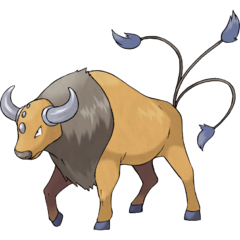



Tauros was a Safari Zone exclusive in Red, Green, Blue, and Yellow, and, due to how rare they are to find and how prone it is to run away, they are usually the very last Pokémon you needed to complete your Pokédex (unless Chansey was really living up to their name). They have a very good Attack stat, but what's most surprising is their Speed. This made Tauros a top-tier Pokémon back in the old days, though Power Creep and changing mechanics has made Tauros stand out less. In the Alola region, there's a tradition of using Tauros as a Poké Ride. Not only are they fast, but they can also smash rocks that are in the way.
In the Paldea region, three distinct breeds of Tauros have developed as regional forms referred to as "breeds," each distinguished by horn shape, color, body build and the way they hold their tails. The Combat Breed is a pure Fighting type that uses its short, stout horns for fighting in close-quarters, while the Fighting/Fire Blaze Breed and Fighting/Water Aqua Breed imbue their specialized horns with fire and water elemental powers respectively. Paldean Tauros forms are somewhat slower than normal Tauros, but also somewhat bulkier and stronger.
- Bare-Fisted Monk: Or rather Bare-horned. Paldean Tauros are, depending on breed, fully or partially Fighting-type due to being based on Spanish fighting bulls.
- Barrier-Busting Blow: Tauros learns Raging Bull, which can break barriers such as Reflect and Light Screen.
- Berserk Button: With Anger Point, being on the receiving end of a critical hit will instantly max out Tauros's attack.
- Bizarre Sexual Dimorphism: It and Miltank are apparently the male and female of the same species, yet their physical differences are striking.
- Breaking Old Trends:
- Blaze Breed Paldean Tauros is the first Fire and Fighting type Pokémon to not be an evolution of a Starter Mon.
- Paldean Tauros in general is the first regional form to have three different forms.
- Brutish Bulls: Tauros, the archetypal bull Pokémon, is regularly described in its Pokédex entries as violent, short-tempered, and very fond of charging things down. A Tauros with no enemy to charge will take out its frustration by ramming and uprooting large trees until it calms down. This is subverted with those native to Alola, which are stated to be somewhat calmer and more even-tempered than those found elsewhere in the world.
- Close-Range Combatant: Combat Breed Paldean Tauros are noted to have shorter horns than other variants because it allows them to more easily target an opponent's weak spots at close range.
- Hair-Trigger Temper: Tauros are noted for their violent dispositions, especially Paldean Tauros, which are based on Spanish fighting bulls (which are deliberately bred to be aggressive). Tauros native to Galar are also said to be especially volatile.
- Heli-Critter: Aqua Breed Paldean Tauros swim by spinning their three tails like the propellers of a boat.
- Horse of a Different Color: In the Gen VII games, Tauros is available as one of the mounts available through the Ride Pager.
- Lightning Bruiser: It's fast, strong, and has good defenses, with only its Special Attack being lacking.
- Magically Inept Fighter: Tauros has a good base 100 Attack, but a poor base 40 Special Attack (30 for the Paldean forms).
- Making a Splash: The Aqua Breed of Paldean Tauros is part Water-type and can fire jets of water from its horns for either attack or propulsion while swimming.
- Multiple-Tailed Beast: Tauros has three tails, and currently provides the page image.
- Nerf: In Generation I, Tauros can take advantage of special moves thanks to its 70 Special stat, which was decent at the time. Generation II turns its Special stat into its Special Defense, leaving Tauros with a measly 40 Special Attack.
- Non-Elemental: Kantonian Tauros is a Normal-type bull Pokémon.
- Non-Indicative Name: Tauros's Japanese name means "centaur" despite not being one.
- One-Gender Race: Tauros is always male.
- Playing with Fire: Blaze Breed Paldean Tauros are part Fire-type and generate fire through their horns.
- Power Glows: Blaze Breed Tauros' horns glow red for certain move animations, while Aqua Breed's glow blue.
- Power-Up Mount: In Pokémon Sun and Moon, Tauros is a Ride Pokémon that can break through boulders, similar to the HM move Rock Smash. The charge also allows it to act as a fast mode of travel akin to the bicycles of old.
- Secret Art: Tauros is the only Pokémon that learns Raging Bull, a Normal-type move that breaks through barriers such as Reflect and Light Screen, and changes type based on the types of the variant of Tauros using it. Kantonian and Combat Breed Tauros are Normal and Fighting-type respectively, while the Blaze and Aqua Breeds are Fire and Water-type respectively.
- Shown Their Work: The Tauros native to Paldea are all black and more than happy to charge at you when travelling in the overworld. They are most likely based on the toro bravo breed of bulls, the one that's used in traditional corridas. Toro bravo are also all black and notably fierce, even more than bulls of other breeds, because they have been selectively bred for aggression to provide for the best entertainment. This is moreso hindsight, but only bulls are allowed to participate in corridas; Tauros is (and always has been) a male-only species.
- Status Infliction Attack: Tauros's Hidden Ability of Sheer Force defies this, as any attack that has a chance of inflicting a status effect forgoes that chance to gain a power boost instead (in addition to ignoring the recoil from Life Orb when using such attacks). It somewhat compensates for the Special split in the Gold/Silver days, turning its special movepool from "useless" to "could possibly hurt something".
- Took a Level in Kindness: Tauros native to Alola are still as fierce as ever, but they supposedly have a measure of calmness over the rest of their kind.
- Toros y Flamenco: Paldean Tauros are based on Spanish bulls used in bullfighting.
- Underground Monkey: Tauros notably has three regional variants in Paldea, all partly Fighting-type.
- Unstoppable Rage: Tauros is one of the few Pokémon with the ability Anger Point. If it gets hit by a Critical Hit and survives, its Attack is maximized.
- Useless Useful Spell: Its special movepool is massive and include high-powered moves of many types. Too bad its Special Attack is downright unusable.
- You Will Not Evade Me: Tauros naturally learns Pursuit, which can deal a hefty hit to an opponent that's trying to switch out on the turn its used.




